Welcome to another hagiography of an acdemic career built on fabricated research results, brought to you by Smut Clyde. Today’s Photoshop hero is professor Yogeshwer Shukla, a highly distinguished Indian expert of toxicology, cancer research, proteomics and recently also nanotechnology, where he announced to cure cancer with nanoparticles soaked in Ayurvedically-relevant plant extracts. Shukla spent his entire career at the CSIR-Indian Institute of Toxicology Research (IITR) in Lucknow, where he has practised his art for almost 35 years since his early days of PhD in 1984, and where he now made it as Chief Scientist of Food, Drug and Chemical Toxicology.
The man who is not afraid to use a mango or even a pomegranate to kill cancer, received awards from the Indian Society of Health, Environment, Education and Research, for his Photoshop contributions in the field of cancer chemoprevention. Shukla, who probably will proclaim resveratrol’s antioxidative powers even after his 5th bottle of red wine, also used to be the General Secretary of Environmental Mutagen Society of India and the Indian Society of Toxicology. Despite having published oodles of peer-reviewed artworks, Professor Shukla’s due recognition in form of retractions was so far unjustly sparse: just 3, one for plagiarism in 2012 and two for data falsification in 2019.
![Screenshot_2019-05-29 Retraction notice to Theaflavins induced apoptosis of LNCaP cells is mediated through induction of p5[...]](https://forbetterscience.com/wp-content/uploads/2019/05/screenshot_2019-05-29-retraction-notice-to-theaflavins-induced-apoptosis-of-lncap-cells-is-mediated-through-induction-of-p5....png?w=950)
Professor Shukla’s visits abroad were rare and brief, like to WHO-IARC in Lyon, maybe his hosts didn’t like the competition. The great moustache wearer, now aged 55, rather prefers admirers to come to him. He organised the annual meeting of Environmental Mutagen Society of India in 2002 and in 2005, and more recently, was appointed as the Organising Secretary for the next year’s Environmental Mutagen Society of India in 2020. This eulogy is meant to promote Professor Shukla’s academic reputation and national fame to some new heights he might have never expected to reach.
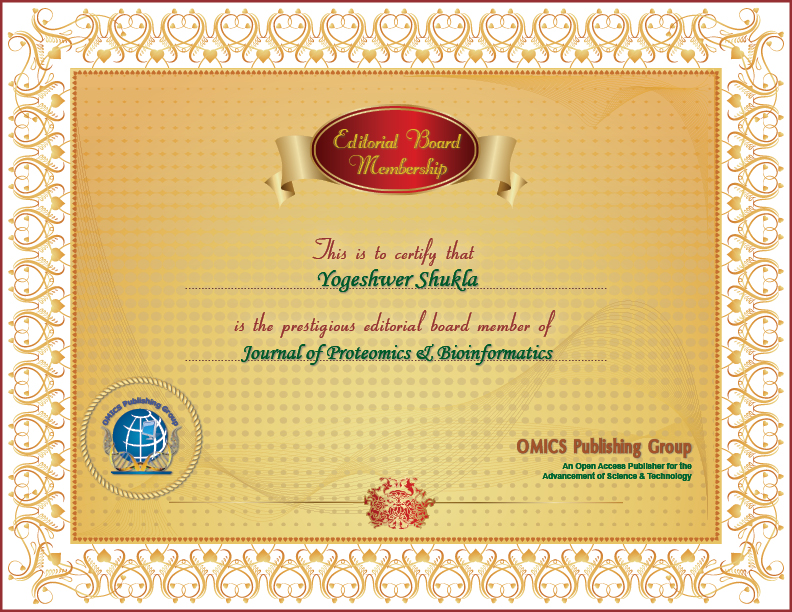
Another green world, by Smut Clyde
These mice were treated for cancer in 2014, using nano-encapsulated pineapple-squeezed bromelain (VII and VIII are identical twins) [1].
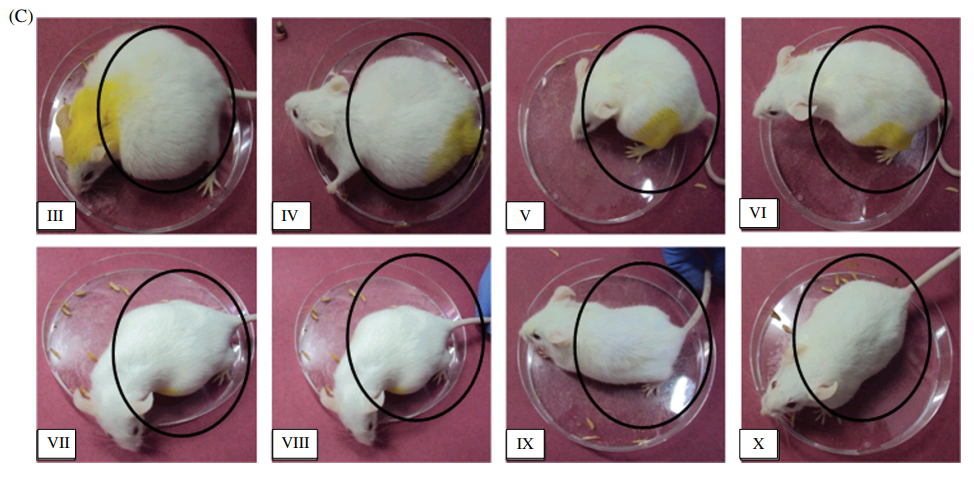
Not only was the treatment successful, but it prolonged their lives long past the usual murine span so they could be treated for cancer again in 2018, this time using nano-encapsulated barberry squeezings [2].
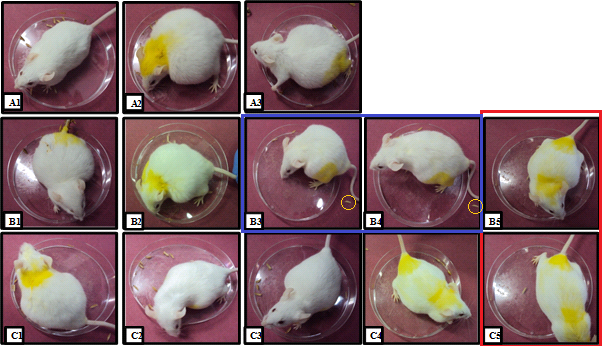
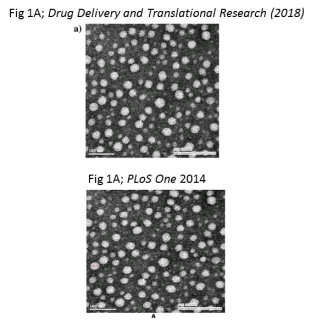 Some uncertainly lingered whether the nano-encapsulation involved “Hyaluronic acid-grafted PLGA” or “O-Hexadecyl-Dextran” [3].
Some uncertainly lingered whether the nano-encapsulation involved “Hyaluronic acid-grafted PLGA” or “O-Hexadecyl-Dextran” [3].
The history of “medicinal pineapple” is in fact an interest of mine (I suspect it may be inspired by the verbal resonance between Ananas and Ananias, the patron saint of liars). It began with a German charlatan who reasoned that Bromelain is a meat-softening enzyme. and tumours are made of meat. Anyway, our rodent friends provide a convenient entry point to the cuisine-based corpus of Professor Yogeshwer Shukla at CSIR-Indian Institute of Toxicology Research (Delhi, India). For with the help of his colleagues and students, Dr Shukla has reported diverse botanical treatments for cancer (in mice!) in the course of his illustrious career… with squeezings from garlic, pomegranates, and mangos as well as pineapples. Also grape-skins and tea-leaves; and extracts from cinnamon, ginger and turmeric. Sometimes in isolation, sometimes in synergistic combination. It is as if an unlikely concatenation of events had led to the acceptance of a nouvelle-cuisine cookbook as a grant proposal.
As is the custom of my people, I shall draw heavily on comments left at the ‘PubPeer’ website, where 40 threads are currently devoted to discussing specific papers from his oeuvre. Some of those papers have been retracted, but surprisingly few in light of the unabashed data frauds they display. I can promise a promenade of hedgehogs, in illustration of Clyde’s First Law (“Everything is better with googly eyes”) [4].
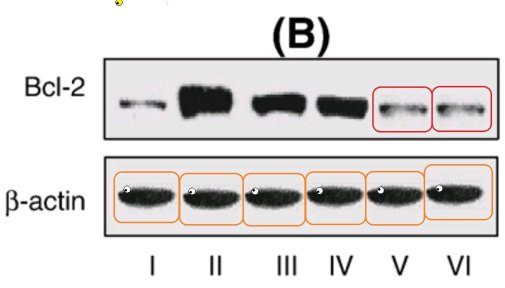
But gratification deferred is gratification doubled, and to heighten the dramatic tension I’ll begin with a peripheral figure: Sahdeo Prasad, now Instructor at Texas Tech University Health Sciences Center, one shudders to think what he instructs people in, given his own record. The PubPeer archives for Prasad namely show him participating in much of the output from Shukla’s output — perhaps as a grad or post-grad student — around 2007-2009, a notably productive period for the laboratory. After that he ascended to the MD Anderson Cancer Center (University of Texas) to work with Bharat Aggarwal and co-author a string of papers, later retracted because the amount of fabrication in them exceeded editorial tolerance. Prasad now collaborates with the mendacious scoundrels at OMICS, and also edits journal-shaped dumpsters for Longdom Publishing (an OMICS polyp).
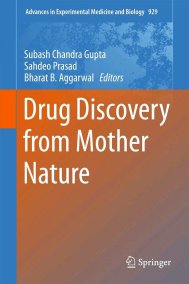 Now Aggarwal’s name should be familiar. He was a pioneer in the field of ‘Jurisprudential Science’, which is where you prove the validity of your theories and results by issuing bumptious, censorious legal threats against your critics. If Jurisprudential Science is not yet the title of a parasitical journal from OMICS, it should be. Disgrace as a con-man and departure from the MD Anderson did not greatly discommode Aggarwal’s career. He continued to publish in Frontiers journals (aided by the complaisance of his quondam colleagues as editors and reviewers), and to star as a guest speaker at magical-thinking scamborees on “curing cancer with culturally-significant herbs and spices”.
Now Aggarwal’s name should be familiar. He was a pioneer in the field of ‘Jurisprudential Science’, which is where you prove the validity of your theories and results by issuing bumptious, censorious legal threats against your critics. If Jurisprudential Science is not yet the title of a parasitical journal from OMICS, it should be. Disgrace as a con-man and departure from the MD Anderson did not greatly discommode Aggarwal’s career. He continued to publish in Frontiers journals (aided by the complaisance of his quondam colleagues as editors and reviewers), and to star as a guest speaker at magical-thinking scamborees on “curing cancer with culturally-significant herbs and spices”.
Many of the Prasad / Aggarwal impostures emerged from a research goal of finding curative benefits from turmeric (more exactly, from the dyestuff / secondary metabolite curcumin extracted from turmeric), obliging them to fake results because in practice curcumin is a shite drug. Aggarwal also played a role in in the Red-Wine bubble… I do not mean the beaded bubbles winking at the brim of a beaker of blushful Hippocrene, but rather, the swell of enthusiasm for the grape-skin component resveratrol which was going to lengthen lifetimes and cure heart disease and cancer by drinking red wine until people collectively tired of faking positive results.

 The relevance of this little digression is that Yogeshwer Shukla espouses the same “culturally-significant plant product” ethnocentric-pharmacognosy approach to drug development, attempting to bring his artistic practice under the protective aegis of Ayurveda (like Aggarwal, he plays up the medieval-herbalism aspect of the Ayurvedic scammocopoeia and plays down the arsenic / mercury / lead toxic-metal alchemy). It must be tempting for scientists in India to claim that their work vindicates Ayurvedic Traditional Knowledge, so that as champions of Vedic cultural virtues they can call on the political forces of ethnocentric chauvinism to keep themselves dismissal-proof despite incompetence or corruption. As it happens, herbs like caraway and dill are important in my culture, especially their secondary metabolites infused in alcohol, but I do not pretend that Akvavit botanicals are responsible for my unnaturally-extended life-span.
The relevance of this little digression is that Yogeshwer Shukla espouses the same “culturally-significant plant product” ethnocentric-pharmacognosy approach to drug development, attempting to bring his artistic practice under the protective aegis of Ayurveda (like Aggarwal, he plays up the medieval-herbalism aspect of the Ayurvedic scammocopoeia and plays down the arsenic / mercury / lead toxic-metal alchemy). It must be tempting for scientists in India to claim that their work vindicates Ayurvedic Traditional Knowledge, so that as champions of Vedic cultural virtues they can call on the political forces of ethnocentric chauvinism to keep themselves dismissal-proof despite incompetence or corruption. As it happens, herbs like caraway and dill are important in my culture, especially their secondary metabolites infused in alcohol, but I do not pretend that Akvavit botanicals are responsible for my unnaturally-extended life-span.
But back to the PubPeer archives. With so many threads, we can only scratch the surface of the iceberg on the seashore and divert ourselves in now and then finding a smoother pebble or a prettier shell than ordinary. Rest assured that curing cancer does not distract Dr Shukla entirely from the ‘Toxicology’ aspect of his institution, and he also studies the carcinogen side of the coin, even if he sometimes confuses Deltamethrin and Benz-α-pyrene, on one hand [5], with Cypermethrin and mezerein on the other [6].
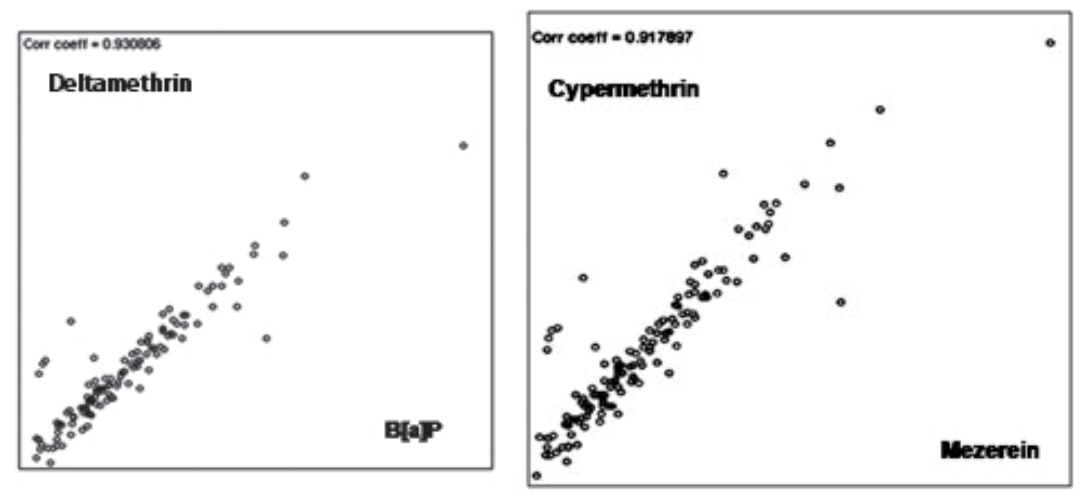
So let’s start with a recent paper (2016) [7], in which the magic of mango squeezings (Lupeol) prevent a fungicide (Mancozeb) from causing cancer. Here are two panels from Figure 2. Now I am not wise in the ways of counting cells by fluorescence and graphing the results as a histogram, but I do know that histograms are supposed to be solid. If they are undercut by erosion or the ravages of termites (marked in red), something is wrong. It is also a problem if fine details are identical in what are purportedly independent experiments (marked in blue).
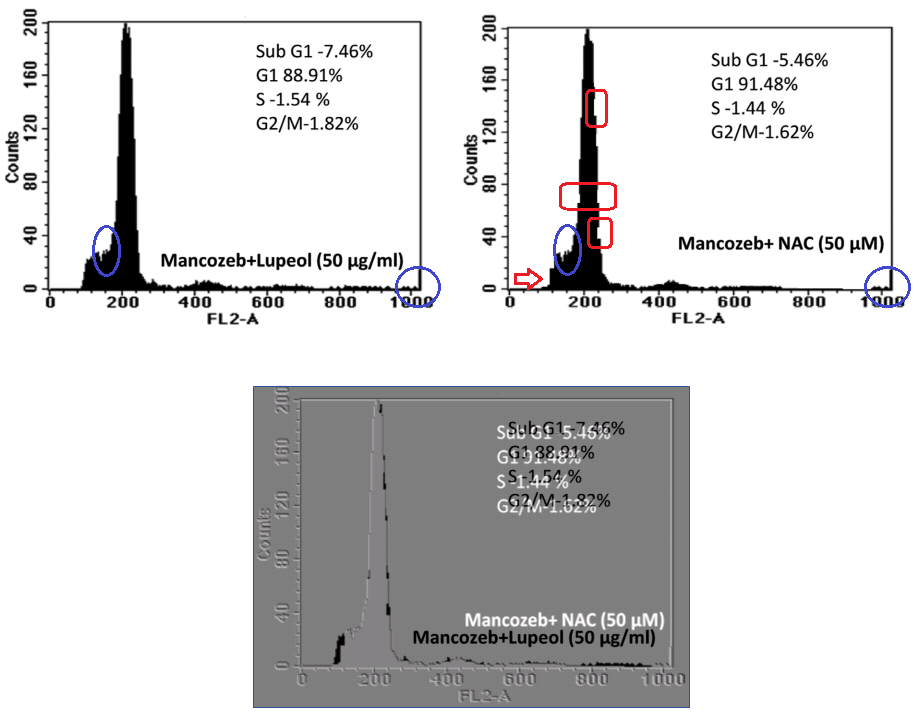
The pixels which were whittled away from the left-hand panel with the Eraser tool show up as black, after black / white reversing the right-hand panel and superimposing it on the former (everything else cancels out). This is MS Paint work, not even Photoshop! This clumsy, lazy falsification is a slap in the face for honest hard-working data forgers who take pride in their workmanship.
Here are earlier examples of white-anted overhanging histograms, from Fig 4A of [8] at left, while the outlined examples at right (from Figure 2 of [9]) are riddled with glitches, like free software:
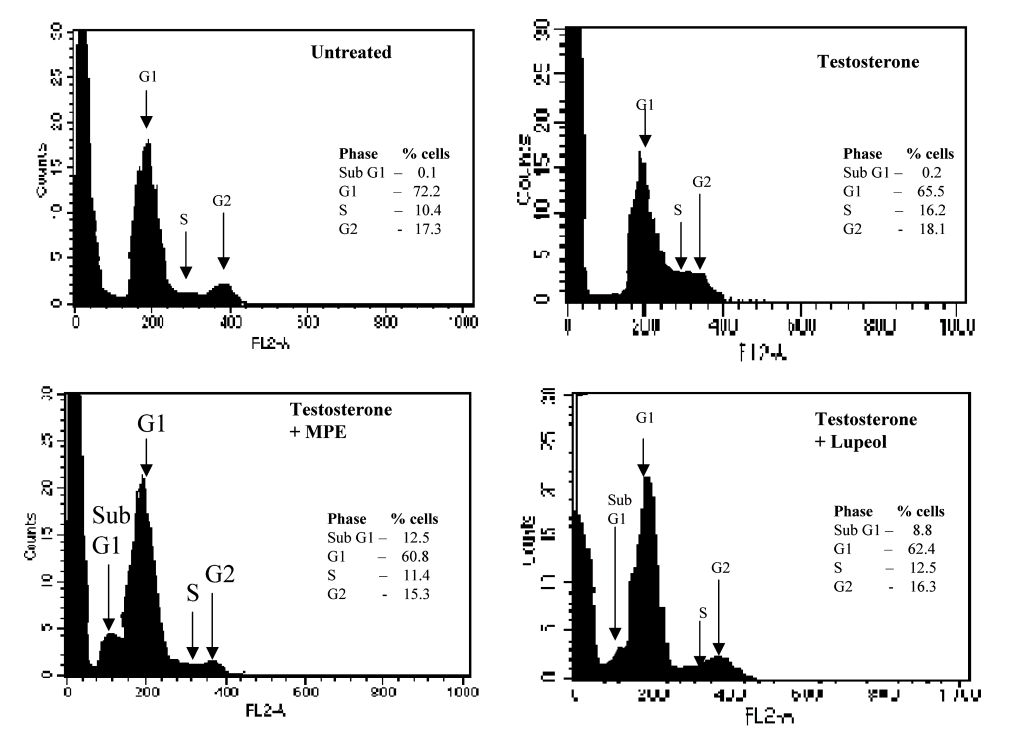
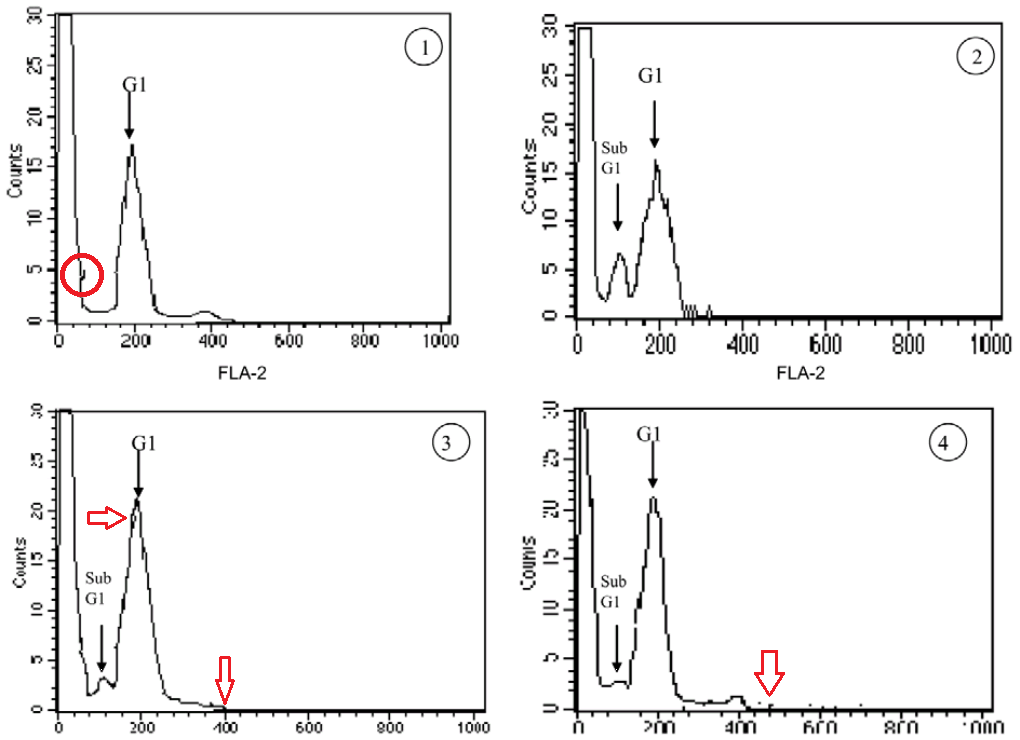
In fact these are snapshots in the process of carving cell-count histograms from scratch. They are like scenes from the creation of a sculpture or a painting, like watching Giaocometti scraping away the clay or pigment he had added in an earlier stage in the cycle. Now [8] still centred on mango juice, while [9] focused on the cancer-preventing powers of garlic… but an overlay of these supposedly-separate data sets shows the sections of perimeter which were not re-worked, and leaves one to wonder if there were any original data measurements at all.
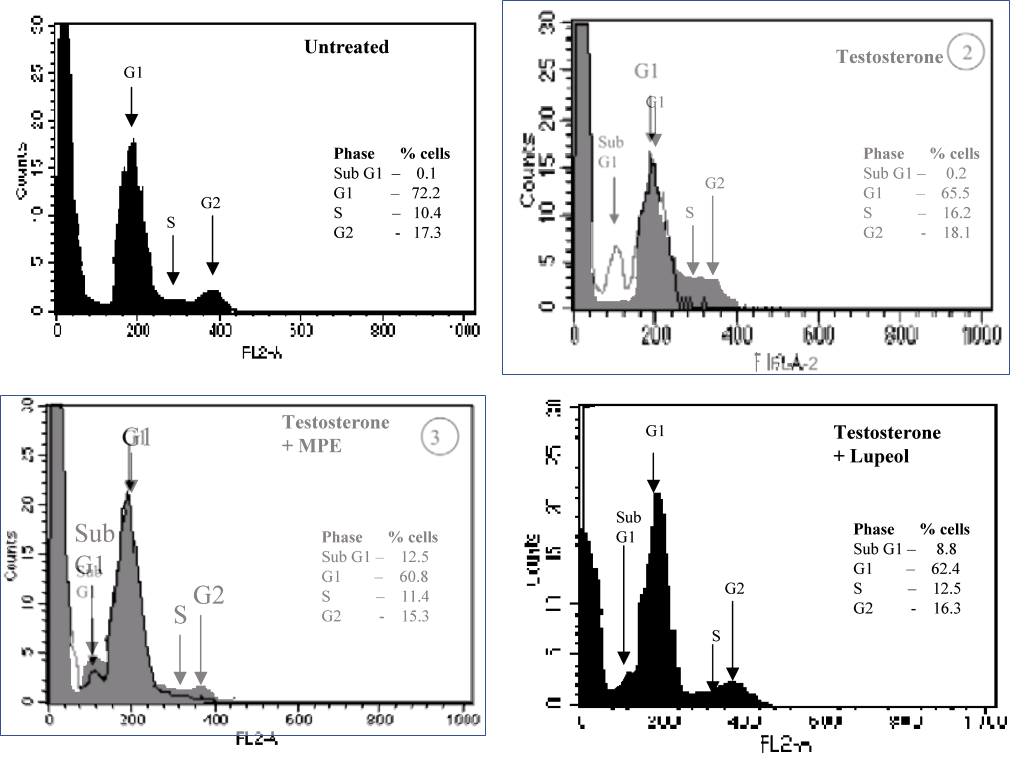
One last example before we move on. In contrast to the toppling minarets in Fig. 4A of [8], what renders 4B risible are similarities among its panels, where only a few pixels were scraped from one and added to another.

When we turn from to Figure 2 of [10], which at least still hoes the row of mango-juice cancer prevention (even though its protective powers are extended over mouse liver cells, rather than lymph node carcinoma of the prostate), it is not too great a surprise to encounter find cell-count plots that are outlined but superimposable.
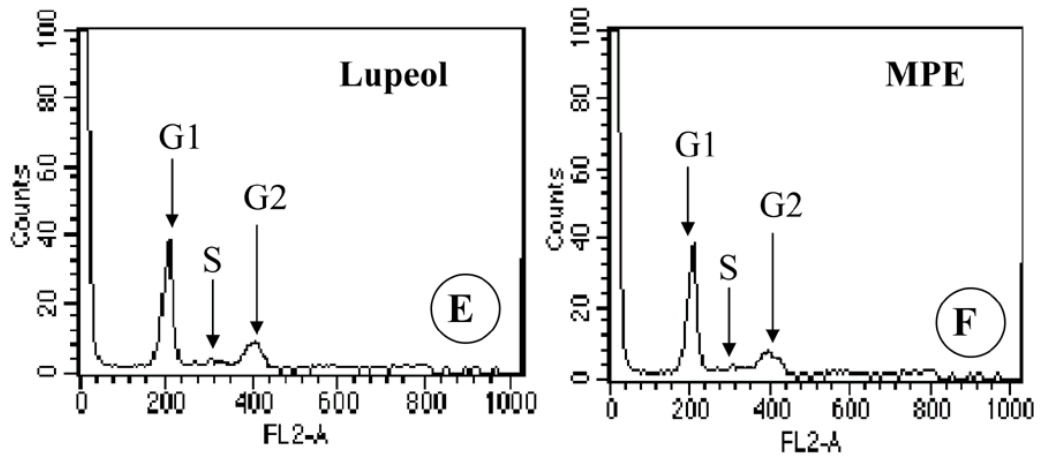
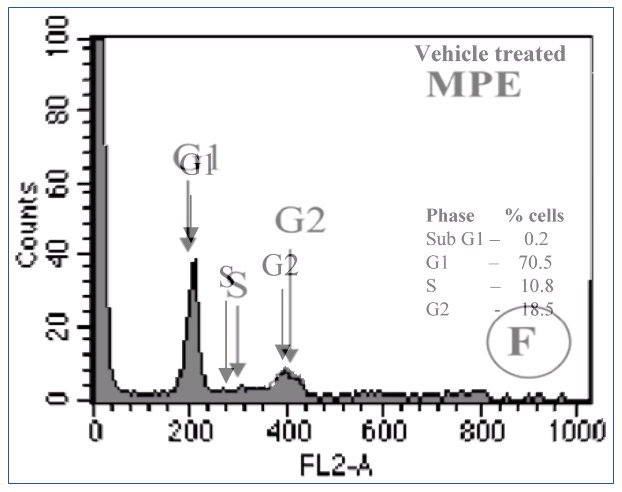
In contrast to histogrammed cell counts, flow-cytometry plots (FACS) measure two fluorescent indicators of each cell’s status and use them as coordinates to plot each cell as a point in two dimensions. They feature prominently in this body of work. They display a recurring quality of insufficient difference. Partial replications could arise when someone took a single file of data (recorded for one experimental condition) and ran it twice through different settings of the filter parameters… but also when someone modified a plot in Paint / Photoshop.
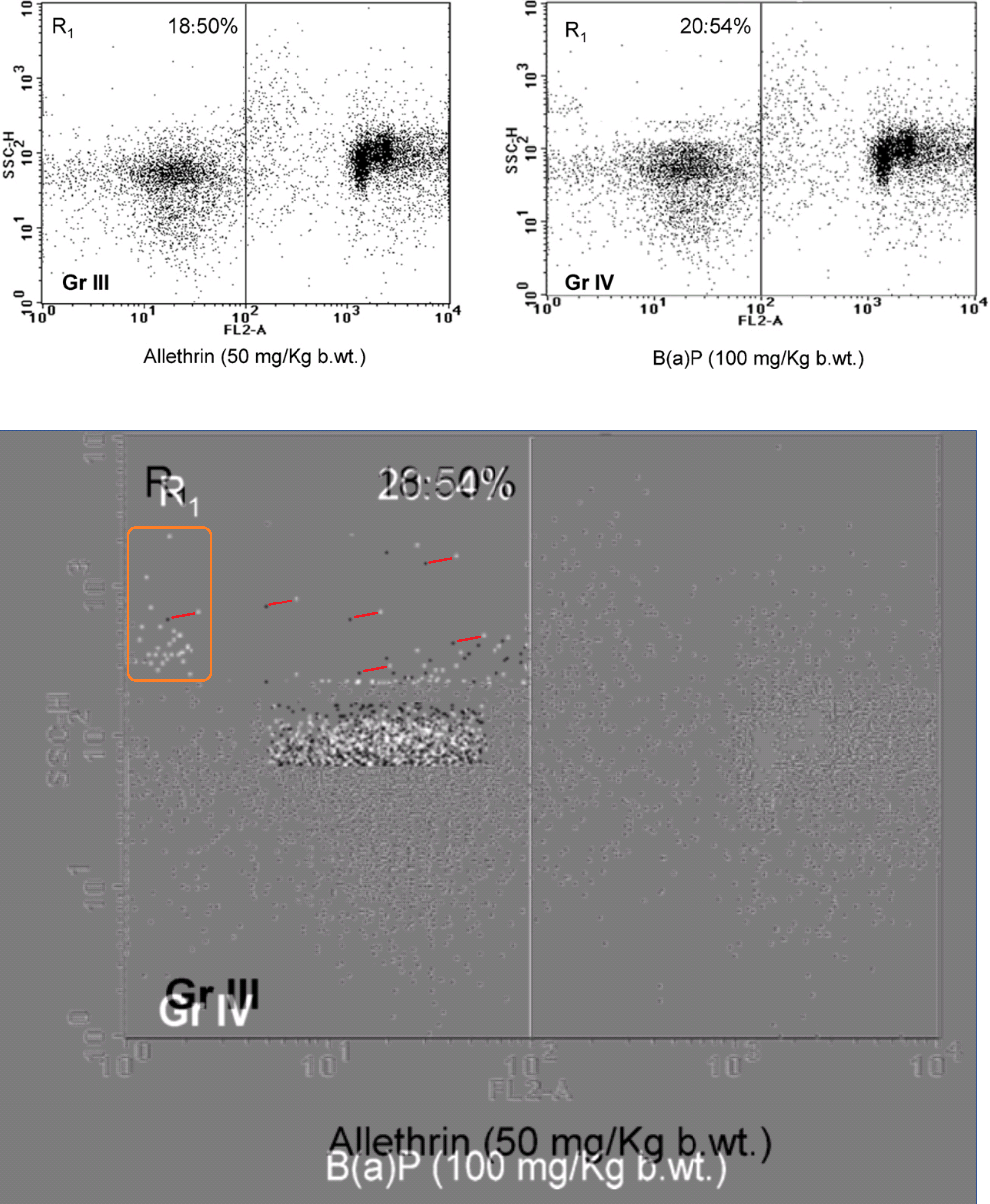 A good example is Figure 2 from a 2012 paper on the mutagenic mayhem wrought by Allethrin insecticide in the absence of mango protection. “Boeckella Robusta” wondered “could authors explain how the same dot plots were generated for different treatments in the indicated boxes?”
A good example is Figure 2 from a 2012 paper on the mutagenic mayhem wrought by Allethrin insecticide in the absence of mango protection. “Boeckella Robusta” wondered “could authors explain how the same dot plots were generated for different treatments in the indicated boxes?”
Indeed, in a superimposition of the Allethrin and Benz-α-pyrene panels, cancellation is complete across three quarters of the plane. There is a patch of white points unique to B-α-P treatment; an exact rectangle of discordant cells; and a zone of black/white pairs where cells were displaced en masse. The forger saw no need for anything sophisticated.
As for the Control panel, res ipsa loquitur.
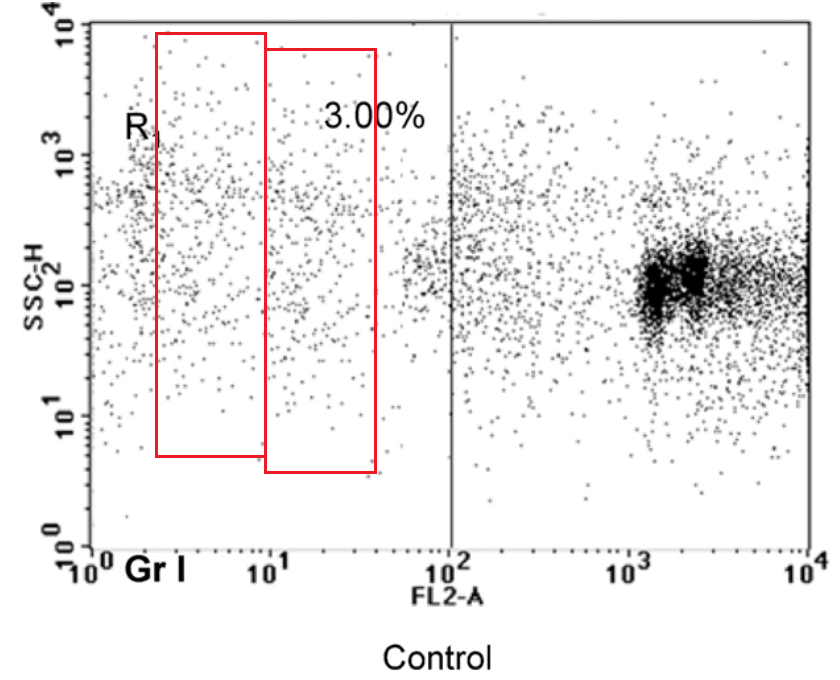
Paper [1] from 2014 gave us the curative nano-pineapples. As “Notarius Cookei” noted, it also provides examples of FACS fakery. Here I choose Figures 6(G) and 6(H), and 9(F) and 9(H).

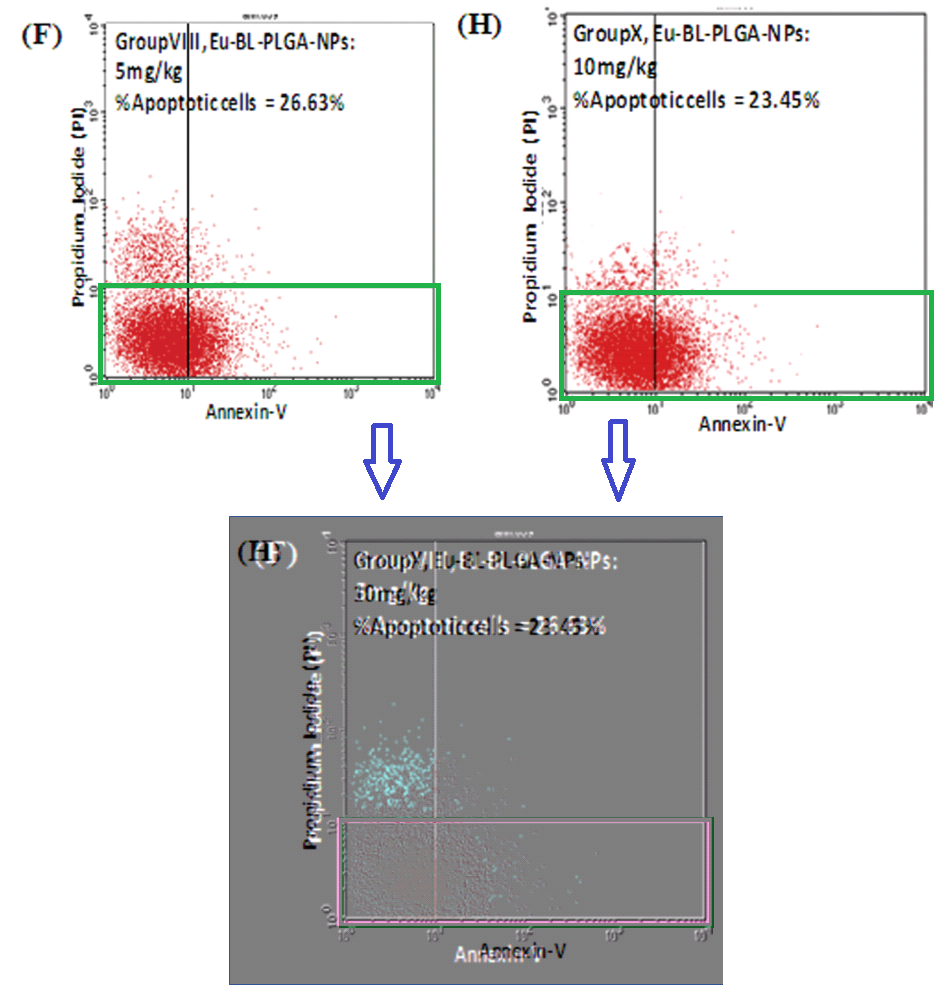
“When 99% of cells are identical in both plots, the most parsimonious explanation is that both plots used the same data.”
I skip over other examples in my haste to reach the delirious heights of [12] and [13]. These companion papers from 2007 and 2008 fed ginger and mangos respectively through the juicer, but the authors liked the FACS plots so much that they used them in both.
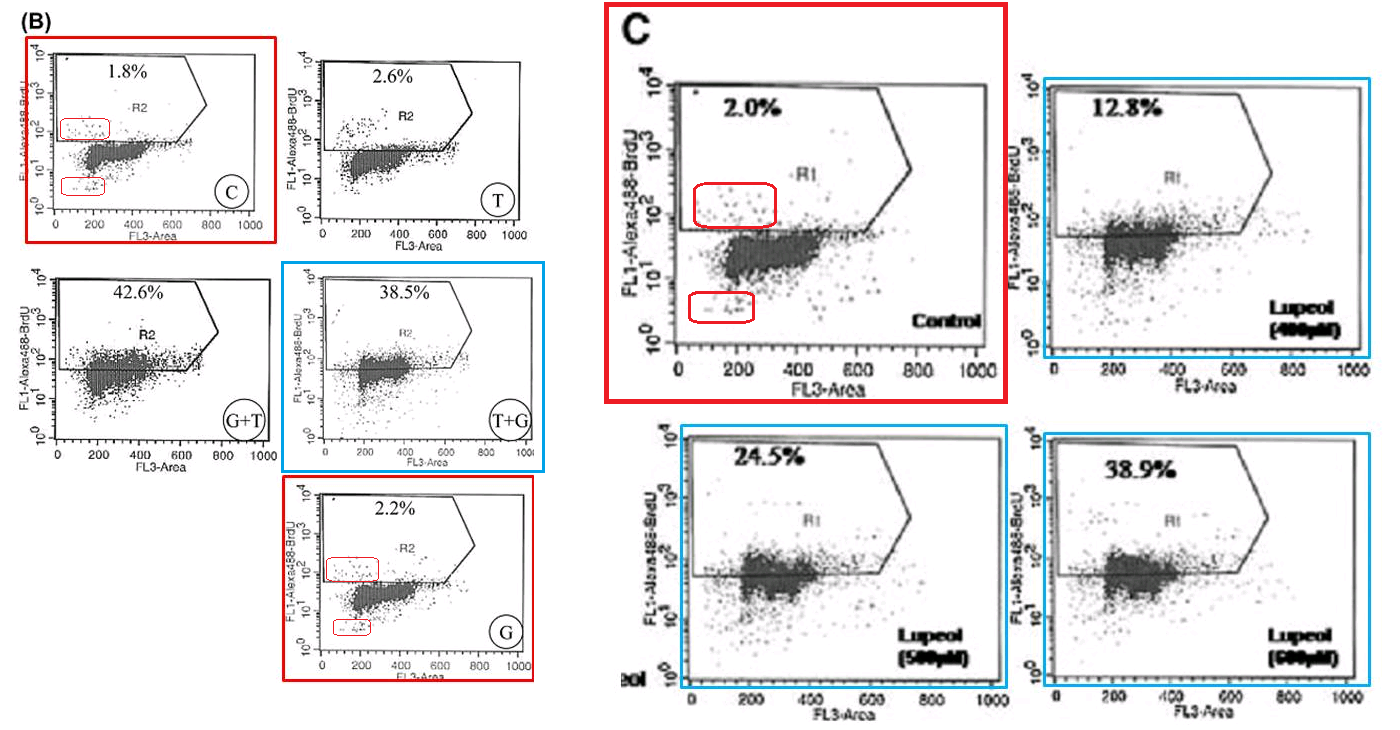
Then someone customised and enhanced each version, cloning clusters of points with all the enthusiasm of a child who has just been introduced to the artistic possibilities of the potato-stamp medium. Figures 5(B) of [12] and 4(C) of [13] should be enlarged to appreciate their plenitude.
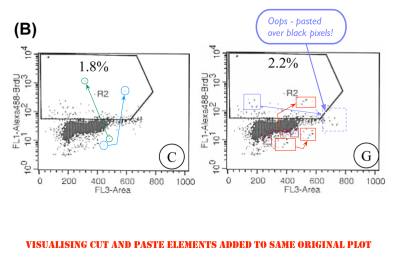
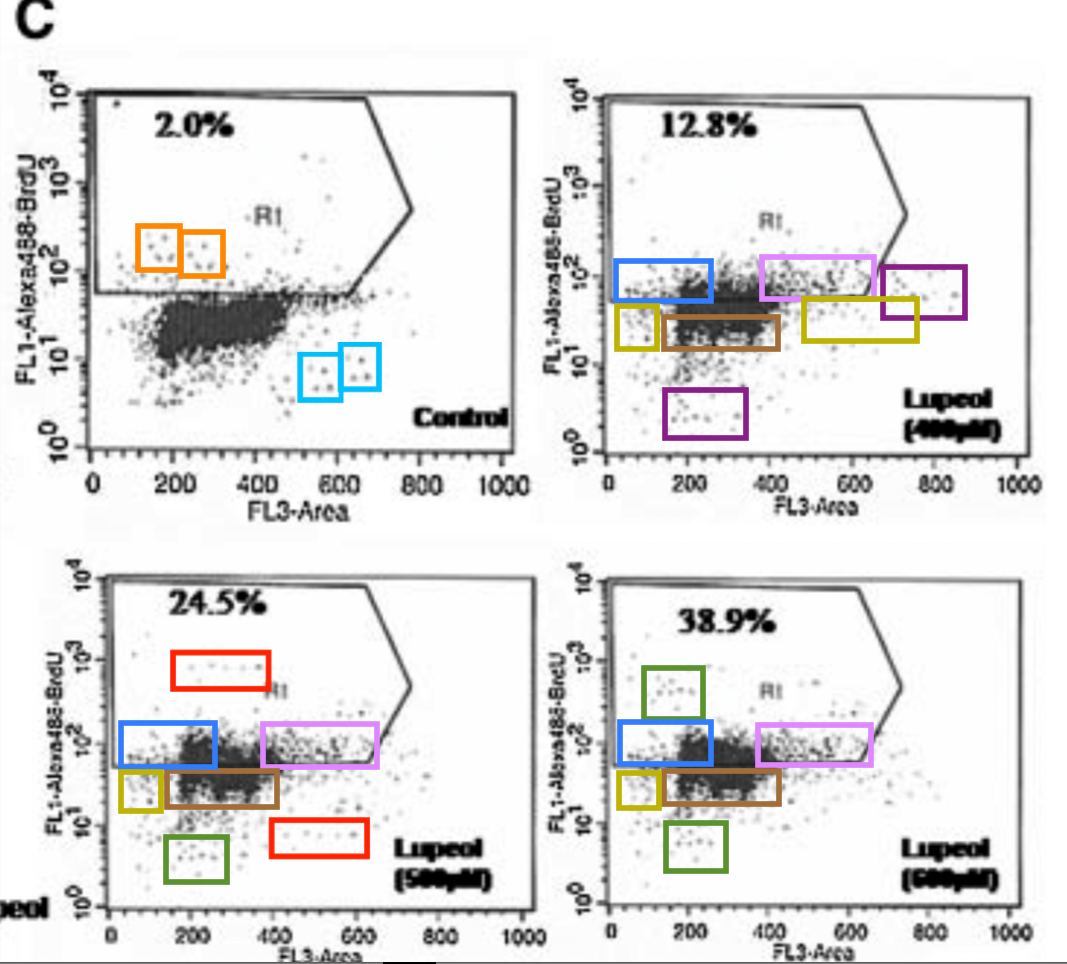
Another spurt of potato-stamp creativity occurred in 2011, in the panels of Figure 6 of [14]. The prospect of inhibiting the growth of skin tumours (in mice) with a synergistic combination of grape-skins and black tea evidently distracted the reviewers’ attentions from the crystalline alignment of the FACS plots.

It also emerged that garlic and pomegranates, together, exerted exactly the same inhibition, resulting in a companion paper [15]. I do not rate for this recipe.

A lot of work went into these constructions, possibly more than simply conducting an experiment would require, so one can understand the authors’ decision to repeat them across papers. Suffice to say that the cloning tool contributed to Figure 6 of [15].
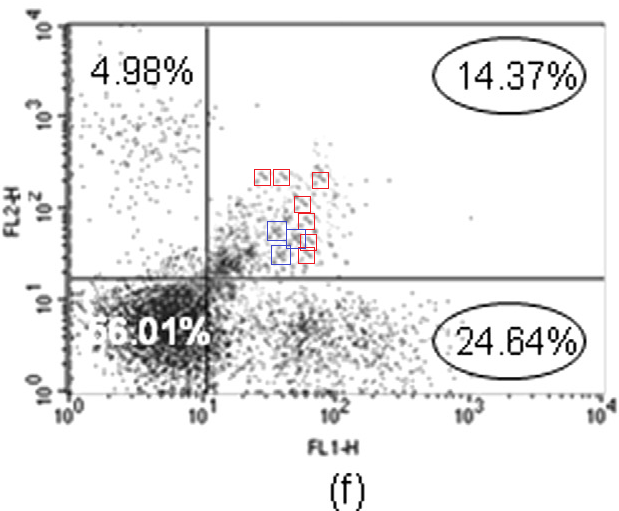


Regrettably, [14] was retracted in April for a number of reasons (not just Figure 6). The world of science was thereby deprived of a row of hot-dogs comprising the ERK1/2 band of Figure 2.
These provide a segue to the inevitable Western-blot discussion. For this body of work has its fair share of gel bands with acrobatic talents, somersaulting and stretching and reflecting as they re-identify from one Protean protein to another (and from one paper to another). Figures 3, 4 and 6 from [16]:
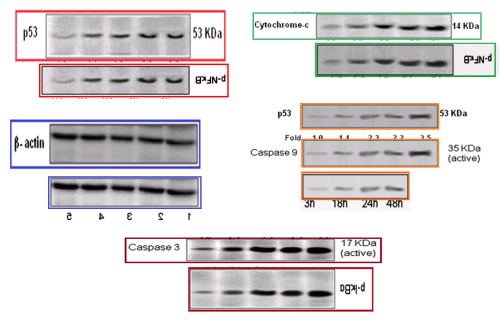
The next somersaults are lane-specific and require more skill. At left, Apaf 1 (from Fig 5B of [4]) becomes Cytochrome C (in Fig 3(d) of [17]). At right, p21/ras (from 2(b) of [18]) becomes AKT (in Fig 5(b) of [17])!
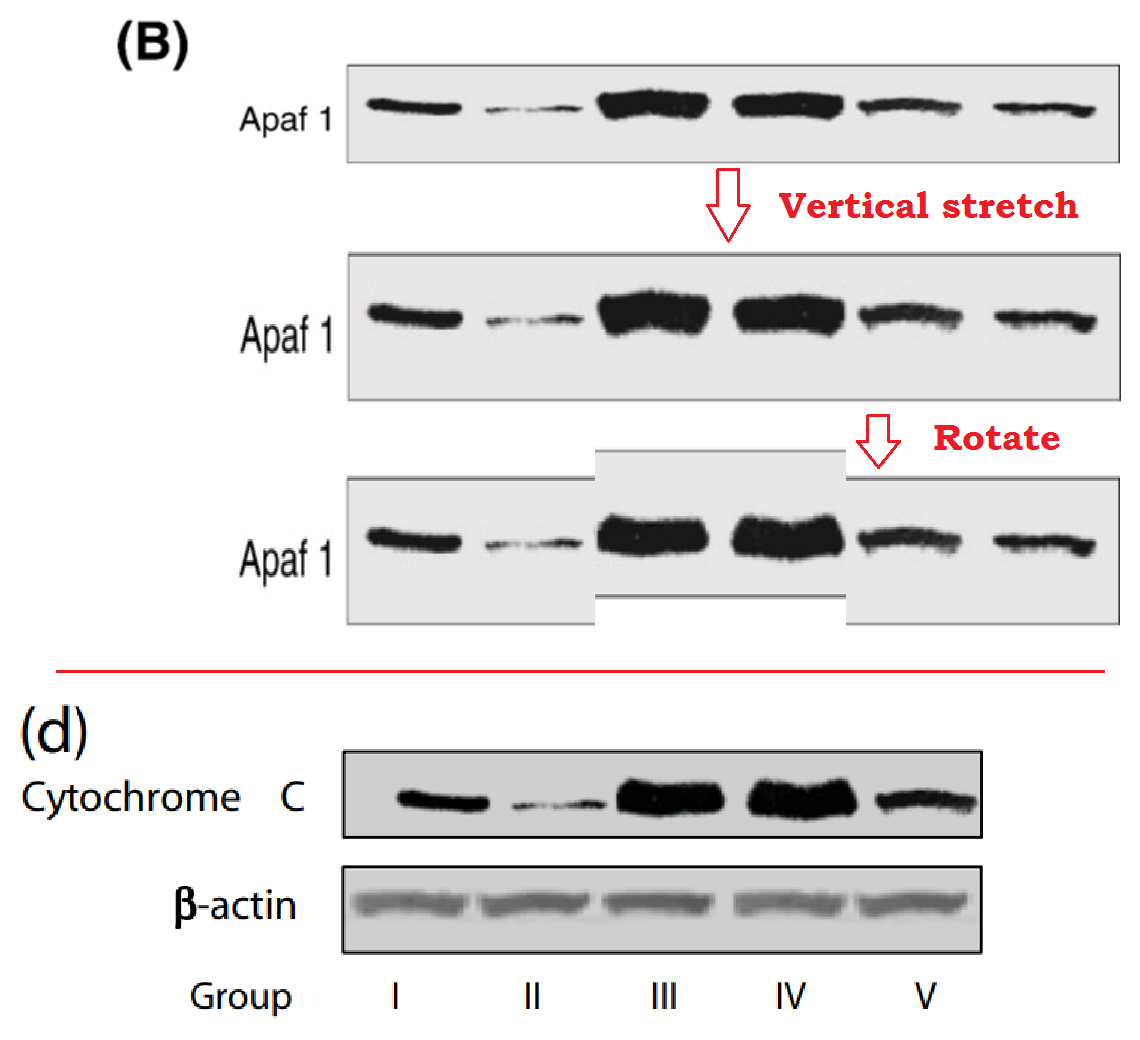
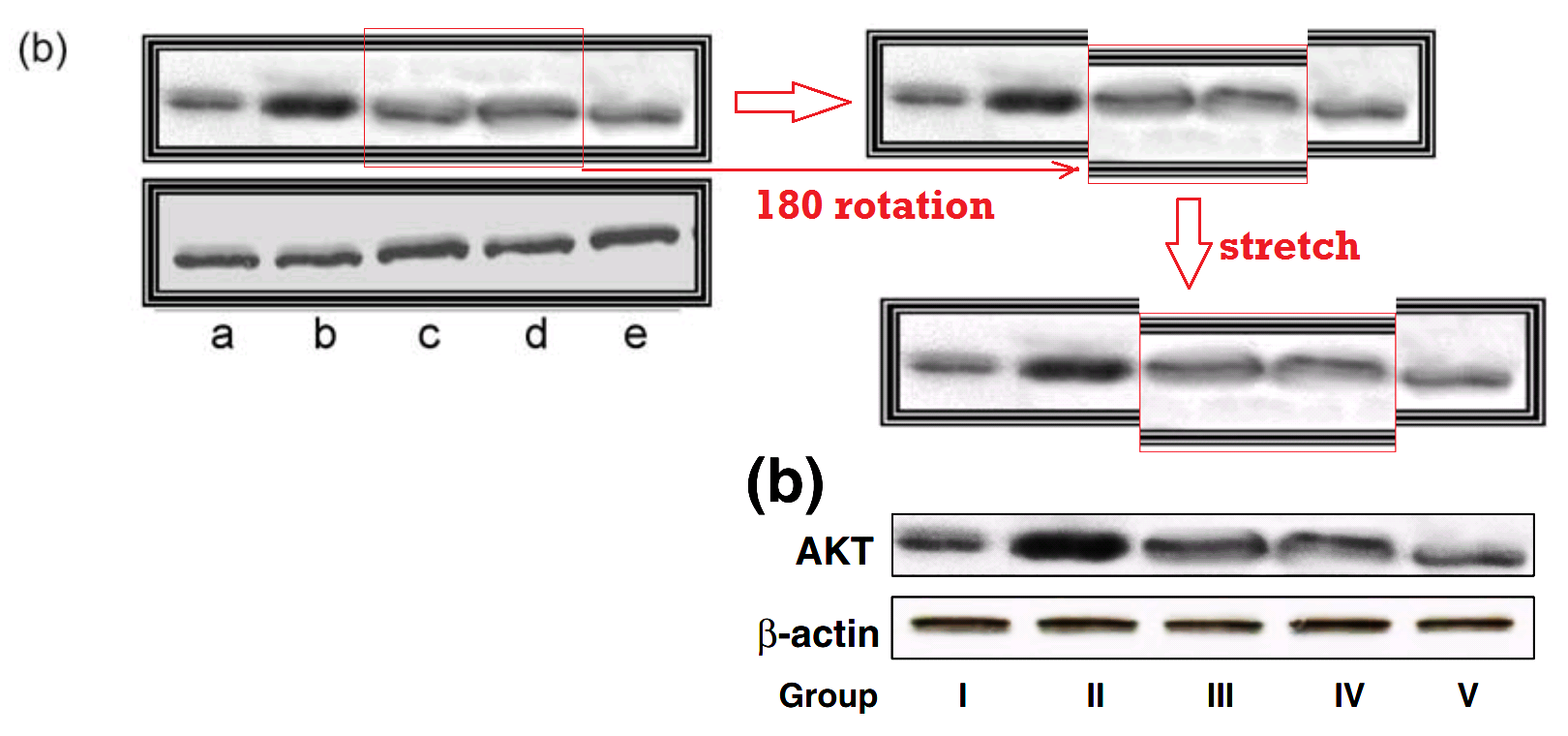
At one end of the spectrum of manipulation, blots might be repeated in successive figures with different labels, relying on the incuriosity of readers and reviewers. At the other extreme, they are cut up and reassembled like letters in a ransom note. Here from [19] to [20].
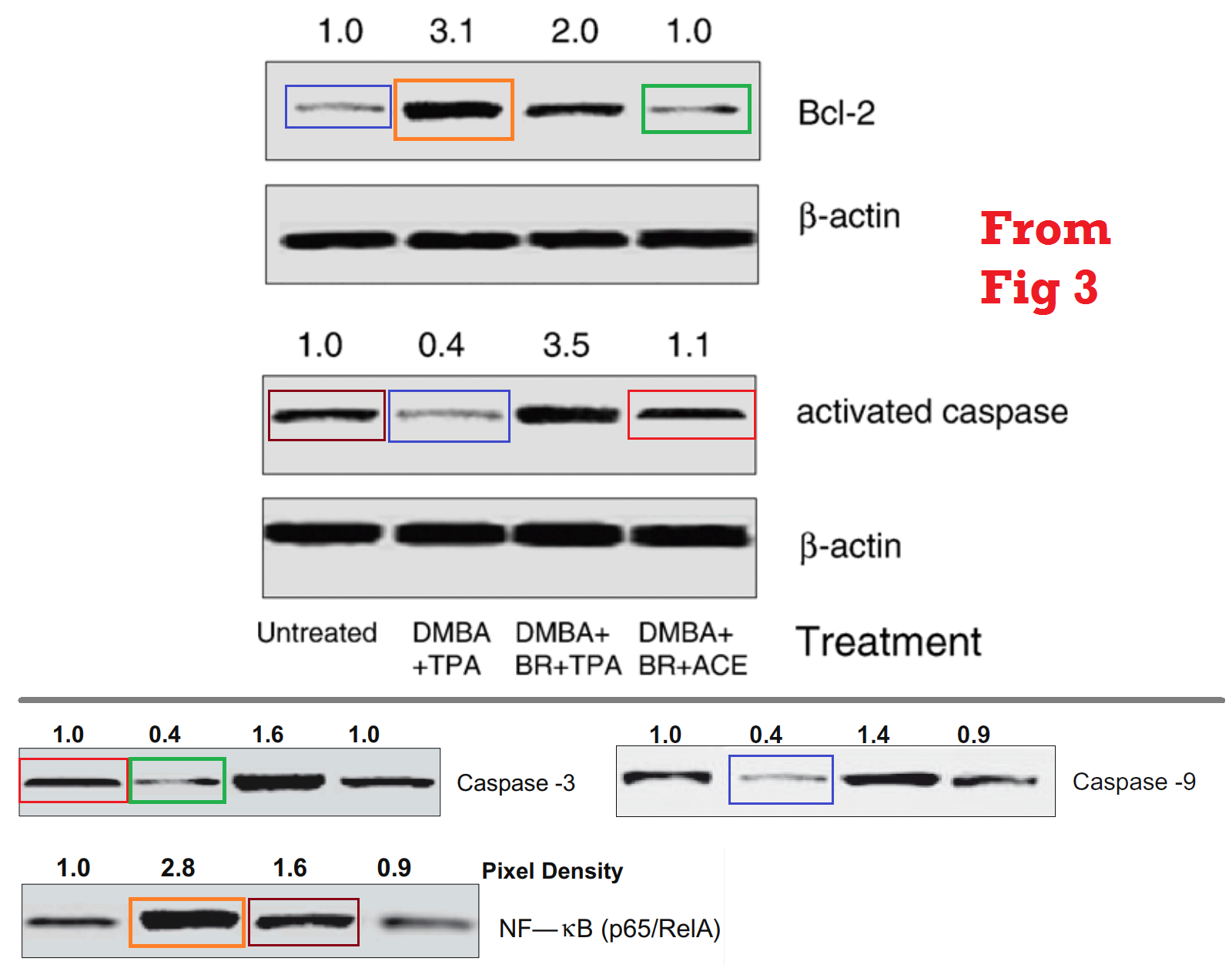
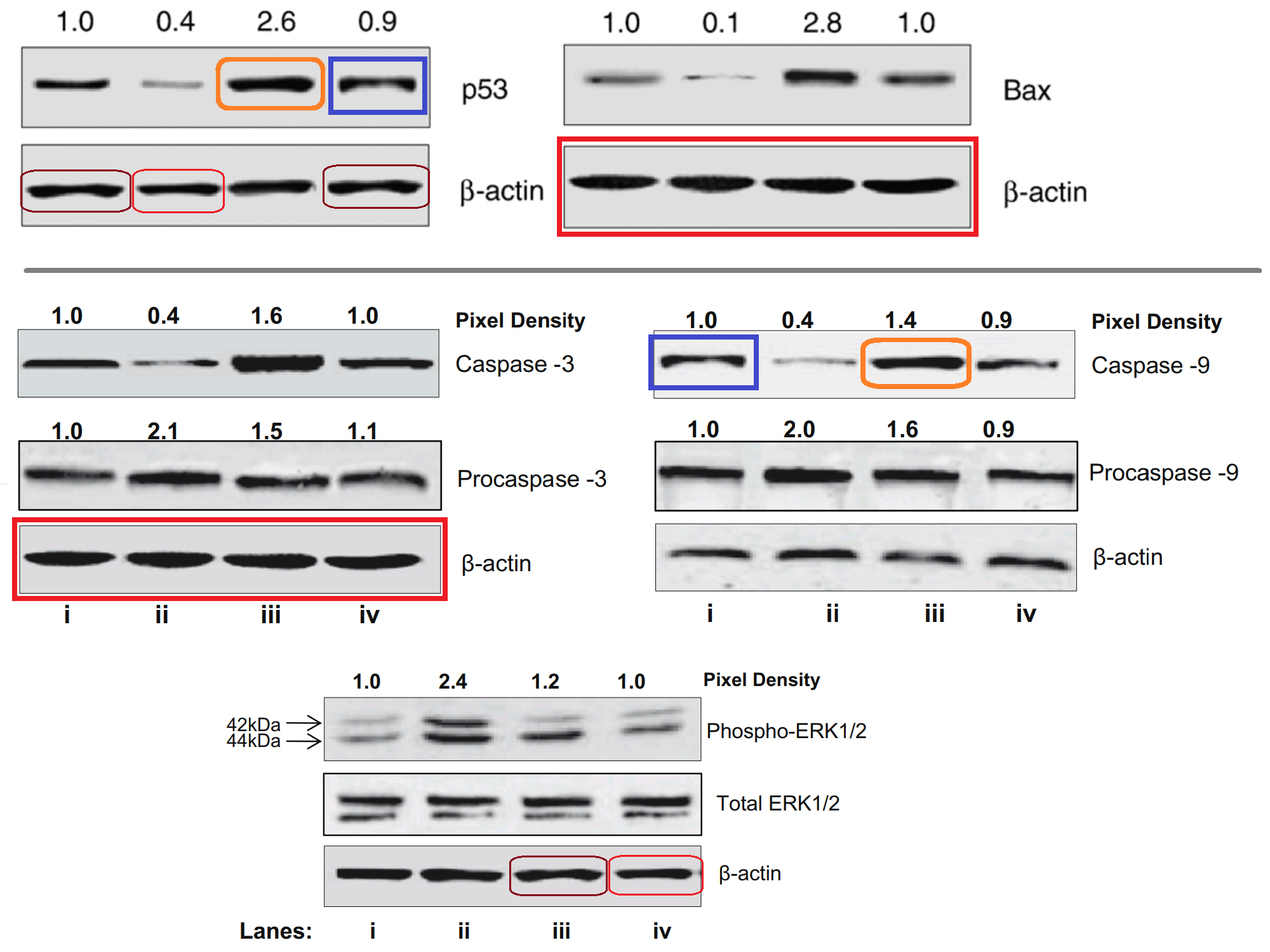
All this is for substantive protein measurements. The normalising controls fare no better. As interest in Shukla’s productions grew, ‘Orophea Enterocarpa‘ identified a small but hard-working repertoire of loading controls. The ‘bubble and hairline’ control, for instance, first spotted in 2004 with five lanes for five experimental levels of garlic [21], has at least nine recorded sightings, sometimes cut down to four lanes or extended to six with a lane duplication to meet the details of the study design. These lanes corresponded to dosage of tea [22, 24], mango / lupeol [8, 10], grape-skins [4, 17, 23] and pineapple [19]. In its most recent appearance (2010) it widened to an eight-lane Interstate highway.

The “scrolls” were another hard-worked loading-control panel with five sightings [8, 12, 17, 18, 22]. Sadly, there is not space to show the “inchworm” panel, or the “dotted dashes“, or the “Nike Swoosh“, or even the “dashes-and-dots” in their four- and eight-lane incarnations.

My favourite in this little genre began in 2008 as Fig 3(A) of [4], holding sway over six variants of grape-skin therapy. It reappeared as a four-lane version as Fig 1(B) of [20], a pineapple study (other panels of 1(B) also repay attention); and in Fig 3 of [19]. Pay attention to the third (or first) lane: for greater standardisation, it was quadruplicated in another 2009 loading control [23].

While back where we started, [4] also starred Fig 6(B), the “hedgehog promenade”. This proves to be another version of that single lane lane from 3(A), now multiplied six-fold and stretched vertically.
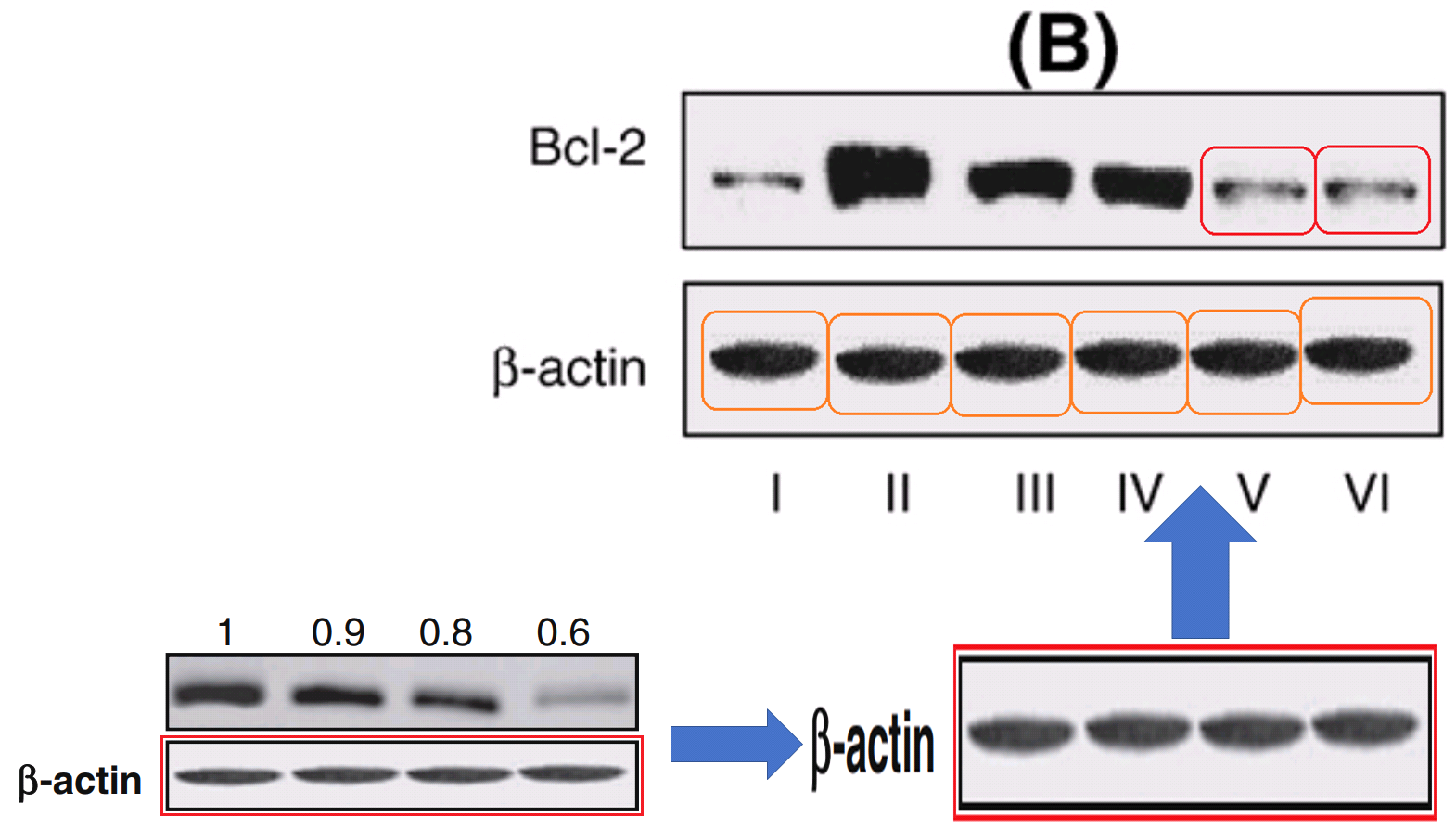
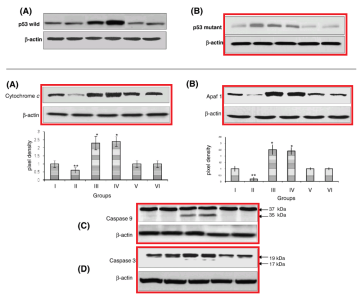 Admittedly, not everyone agrees on the necessity for dose-equalising controls. Between publication of [4] in 2008 and an amendment in 2016, it had featured Figs 3(B) and 5, in which five-lane letterbox panels of β-actin sufficed to normalise a series of six-lane blots of interest. Either the readers and reviewers and editors couldn’t count or they didn’t care.
Admittedly, not everyone agrees on the necessity for dose-equalising controls. Between publication of [4] in 2008 and an amendment in 2016, it had featured Figs 3(B) and 5, in which five-lane letterbox panels of β-actin sufficed to normalise a series of six-lane blots of interest. Either the readers and reviewers and editors couldn’t count or they didn’t care.
Recall the point of compass-coded blotting methods: to quantify the protein expression within cells under specific conditions, by a circuitous but precise route (extracting cell contents and separating the proteins by racing them along an electrophoresis-gel racetrack or Proteodrome, then labelling them with antibodies so as to measure total antibody density). Now it is always possible that researchers did measure all the numbers they tabulate and analyse, producing blots in the process with which they could have illustrated their reports, and they only decide to fabricate the illustrations (or repurpose old ones) because of the artistic challenge.
After all this, there is a sense of relief to be had from meeting plain microphotographs of vat-grown tumour cells from the A549 cell-line, rendered fluorescent by different treatment with black tea polyphenols [16]. Or perhaps they hailed from the HeLa and SiHa cell-lines [25].
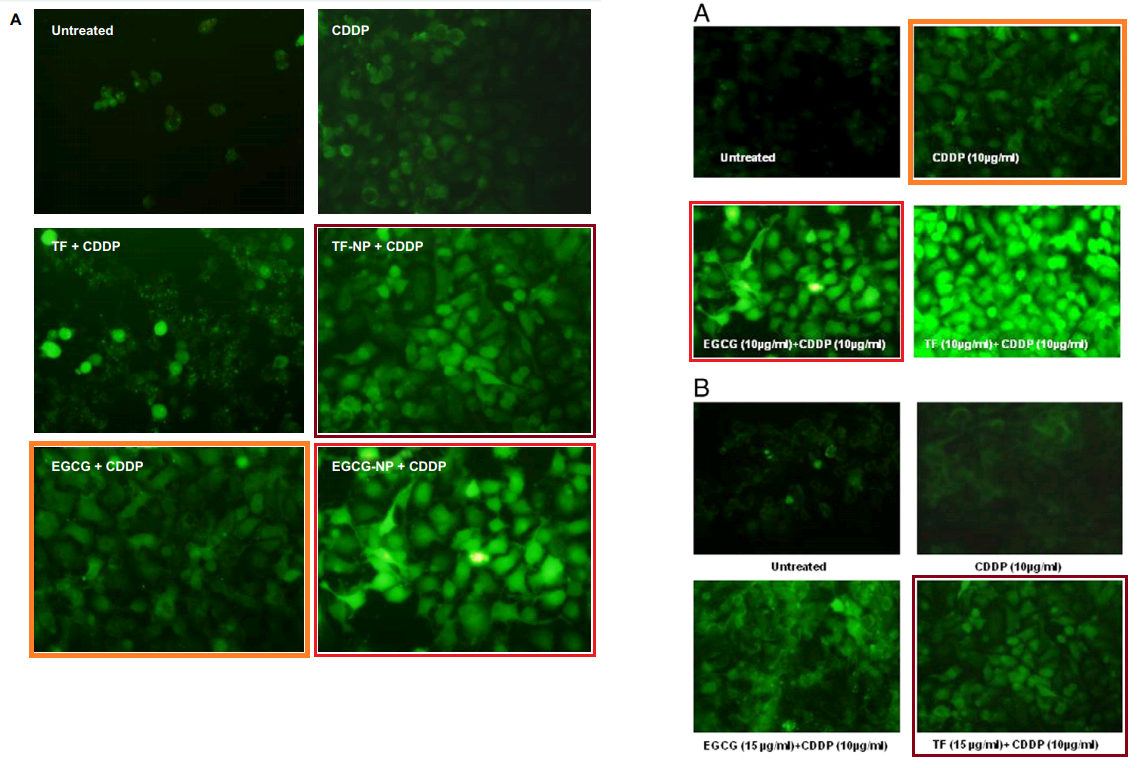
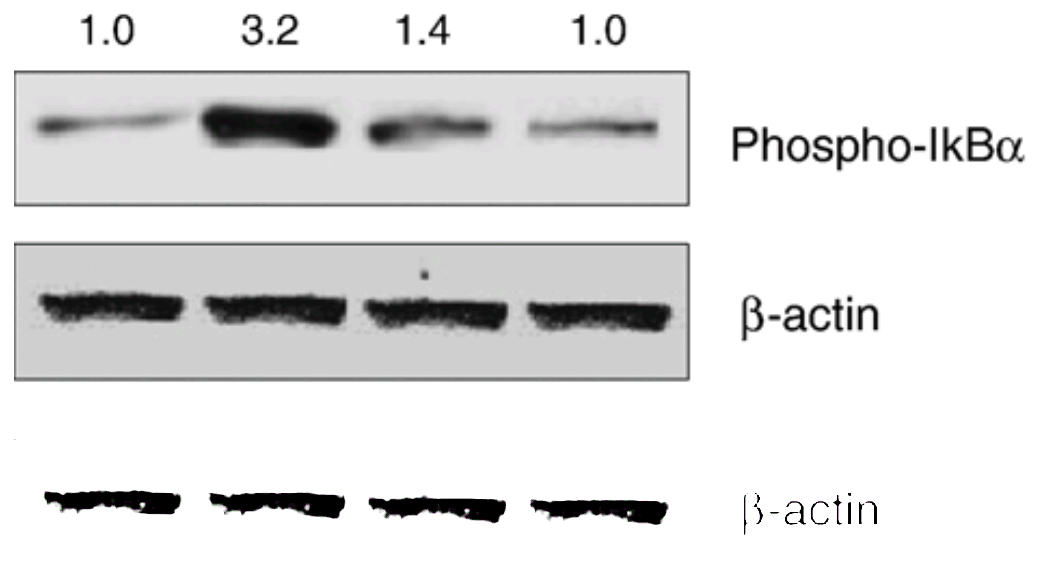 I had originally hoped to show some Northern blots of RNA expression (Caspase-3 becomes iκBα); or perhaps some DNA fragmentation assays, which display a lapidary, mosaic nature when closely examined. But this report is long enough. I must be content with this loading control from [19], which reminds me (when the lightness is turned up) of a row of caddis-fly larvae.
I had originally hoped to show some Northern blots of RNA expression (Caspase-3 becomes iκBα); or perhaps some DNA fragmentation assays, which display a lapidary, mosaic nature when closely examined. But this report is long enough. I must be content with this loading control from [19], which reminds me (when the lightness is turned up) of a row of caddis-fly larvae.
Now I am not alleging retouching or Photoshop manipulations, but there are two images of Dr Yogeshwer Shukla on the Intertubes. The version shown on his staff page at the CSIR-Indian Institute of Toxicology Research website has changed a lot from the version on his ResearchGate account.
If this is the effect of pineapple or mango or grape-skin treatment, he is his own best advertisement for his discoveries.
[1] Priyanka Bhatnagar, Soma Patnaik, Amit K. Srivastava, Mohan K. R. Mudiam, Yogeshwer Shukla, Amulya K. Panda, Aditya B. Pant, Pradeep Kumar, Kailash C. Gupta
Anti-Cancer Activity of Bromelain Nanoparticles by Oral Administration
Journal of Biomedical Nanotechnology (2014) doi: 10.1166/jbn.2014.1997
https://pubpeer.com/publications/D7569FE3179E5C77F10CD7D0CAFF1C
[2] Priyanka Bhatnagar, Manisha Kumari, Richa Pahuja, A. B. Pant, Y. Shukla, Pradeep Kumar, K. C. Gupta
Hyaluronic acid-grafted PLGA nanoparticles for the sustained delivery of berberine chloride for an efficient suppression of Ehrlich ascites tumors
Drug Delivery and Translational Research (2018) doi: 10.1007/s13346-018-0485-9
https://pubpeer.com/publications/17D26A485788CD2B46B52781D8DD50
[3] Radhika Kapoor, Shruti Singh, Madhulika Tripathi, Priyanka Bhatnagar, Poonam Kakkar, Kailash Chand Gupta
O-hexadecyl-dextran entrapped berberine nanoparticles abrogate high glucose stress induced apoptosis in primary rat hepatocytes
PLoS ONE (2014) doi: 10.1371/journal.pone.0089124
https://pubpeer.com/publications/012D4D634C827AE2183864F22FD1A0
[4] Neetu Kalra, Preeti Roy, Sahdeo Prasad, Yogeshwer Shukla
Resveratrol induces apoptosis involving mitochondrial pathways in mouse skin tumorigenesis
Life Sciences (2008) doi: 10.1016/j.lfs.2007.11.006
https://pubpeer.com/publications/4197501DBC472982247DE0AFA234E3
[5] Jasmine George, Yogeshwer Shukla
Early changes in proteome levels upon acute deltamethrin exposure in mammalian skin system associated with its neoplastic transformation potential
Journal of Toxicological Sciences (2013)
https://pubpeer.com/publications/F65D2C5FFC638303800927B2E28661
[6] Jasmine George, Amit Kumar Srivastava, Richa Singh, Yogeshwer Shukla
Cypermethrin exposure leads to regulation of proteins expression involved in neoplastic transformation in mouse skin
Proteomics (2011) doi: 10.1002/pmic.201100233
https://pubpeer.com/publications/A384A6D53974AF627FC83477C2D43E
[7] Amit Kumar Srivastava, Sanjay Mishra, Wahid Ali, Yogeshwer Shukla
Protective effects of lupeol against mancozeb-induced genotoxicity in cultured human lymphocytes
Phytomedicine (2016) doi: 10.1016/j.phymed.2016.03.010
https://pubpeer.com/publications/5AA6712082CCC91EEE90C4C5196BFE
[8] Sahdeo Prasad, Neetu Kalra, Yogeshwer Shukla
Induction of apoptosis by lupeol and mango extract in mouse prostate and LNCaP cells
Nutrition & Cancer (2007) doi: 10.1080/01635580701613772
https://pubpeer.com/publications/5316531EB262091B243859A00C0137
[9] S Prasad, N Kalra, S Srivastava, Y Shukla
Regulation of oxidative stress–mediated apoptosis by diallyl sulfide in DMBA-exposed Swiss mice
Human & Experimental Toxicology (2008) doi: 10.1177/0960327108088978
https://pubpeer.com/publications/92E0808D22F88CCD9F6CB46ACC36A8
[10] Sahdeo Prasad, Neetu Kalra, Yogeshwer Shukla
Hepatoprotective effects of lupeol and mango pulp extract of carcinogen induced alteration in Swiss albino mice
Molecular Nutrition & Food Research (2007) doi: 10.1002/mnfr.200600113
https://pubpeer.com/publications/76E17585B48AC0B38E498B5EC23054
[11] Amit Kumar Srivastava, Pramod Kumar Srivastava, Abdulaziz A. Al-Khedhairy, Javed Musarrat, Yogeshwer Shukla
Allethrin-induced genotoxicity and oxidative stress in Swiss albino mice
Mutation Res/Fund Mol Mech Mutagenesis (2012) doi: 10.1016/j.mrgentox.2012.03.003
https://pubpeer.com/publications/3D8F9A166D74AE68A779582773B7AD
[12] Yogeshwer Shukla, Sahdeo Prasad, Chitra Tripathi, Madhulika Singh, Jasmine George, Neetu Kalra
In vitro and in vivo modulation of testosterone mediated alterations in apoptosis related proteins by [6]-gingerol
Molecular Nutrition & Food Research (2007) doi: 10.1002/mnfr.200700197
https://pubpeer.com/publications/F9BEECCBE9F74B9796BFA11F079FF9
[13] Sahdeo Prasad, Nidhi Nigam, Neetu Kalra, Yogeshwer Shukla
Regulation of signaling pathways involved in lupeol induced inhibition of proliferation and induction of apoptosis in human prostate cancer cells
Molecular Carcinogenesis (2008) doi: 10.1002/mc.20442
https://pubpeer.com/publications/977BFB109F38955F21E8259D74F9C0
[14] RETRACTED: Jasmine George, Madhulika Singh, Amit Kumar Srivastava, Kulpreet Bhui, Preeti Roy, Pranav Kumar Chaturvedi, Yogeshwer Shukla
Resveratrol and black tea polyphenol combination synergistically suppress mouse skin tumors growth by inhibition of activated MAPKs and p53
PLoS ONE (2011) doi: 10.1371/journal.pone.0023395
https://pubpeer.com/publications/1ADC5417FEF462F17636A43498D670
[15] Jasmine George, Madhulika Singh, Amit Kumar Srivastava, Kulpreet Bhui, Yogeshwer Shukla
Synergistic growth inhibition of mouse skin tumors by pomegranate fruit extract and diallyl sulfide: evidence for inhibition of activated MAPKs/NF-κB and reduced cell proliferation
Food & Chemical Toxicology (2011) doi: 10.1016/j.fct.2011.03.040
https://pubpeer.com/publications/4A46821594EB7EB392F5A9BB471E5A
[16] Madhulika Singh, Kulpreet Bhui, Richa Singh, Yogeshwer Shukla
Tea polyphenols enhance cisplatin chemosensitivity in cervical cancer cells via induction of apoptosis
Life Sciences (2013) doi: 10.1016/j.lfs.2013.02.001
https://pubpeer.com/publications/8BC7D198B330260105915A17A97BE7
[17] Preeti Roy, Neetu Kalra, Sahdeo Prasad, Jasmine George, Yogeshwer Shukla
Chemopreventive potential of resveratrol in mouse skin tumors through regulation of mitochondrial and PI3K/AKT signaling pathways
Pharmaceutical Research (2009) doi: 10.1007/s11095-008-9723-z
https://pubpeer.com/publications/850796C5228A56DF71E8D4E4601C87
[18] Annu Arora, Neetu Kalra, Yogeshwer Shukla
Regulation of p21/ras protein expression by diallyl sulfide in DMBA induced neoplastic changes in mouse skin
Cancer Letters (2006) doi: 10.1016/j.canlet.2005.10.049
https://pubpeer.com/publications/A5216BB8F4E05BB3A05E274F56618B
[19] Neetu Kalra, Kulpreet Bhui, Preeti Roy, Smita Srivastava, Jasmine George, Sahdeo Prasad, Yogeshwer Shukla
Regulation of p53, nuclear factor kappaB and cyclooxygenase-2 expression by bromelain through targeting mitogen-activated protein kinase pathway in mouse skin
Toxicology and Applied Pharmacology (2008) doi: 10.1016/j.taap.2007.08.012
https://pubpeer.com/publications/4A3803831AE2603C9276ADB9750A85
[20] Kulpreet Bhui, Sahdeo Prasad, Jasmine George, Yogeshwer Shukla
Bromelain inhibits COX-2 expression by blocking the activation of MAPK regulated NF-kappa B against skin tumor-initiation triggering mitochondrial death pathway
Cancer Letters (2009) doi: 10.1016/j.canlet.2009.03.003
https://pubpeer.com/publications/19913878F1C75788FE95D3FD1FCADE
[21] Annu Arora, Imtiaz A Siddiqui, Yogeshwer Shukla
Modulation of p53 in 7,12-dimethylbenz[a]anthracene-induced skin tumors by diallyl sulfide in Swiss albino mice
Molecular Cancer Therapeutics (2004)
https://pubpeer.com/publications/2DE54FD49EB1CAE22A11E768845A2C
[22] RETRACTED: Neetu Kalra, Kavita Seth, Sahdeo Prasad, Madhulika Singh, Aditya B. Pant, Yogeshwer Shukla
Theaflavins induced apoptosis of LNCaP cells is mediated through induction of p53, down-regulation of NF-kappa B and mitogen-activated protein kinases pathways
Life Sciences (2007) doi: 10.1016/j.lfs.2007.04.009
https://pubpeer.com/publications/916B9A4E38D79FAF24E97FFB891AC8
[23] Preeti Roy, Esha Madan, Neetu Kalra, Nidhi Nigam, Jasmine George, Ratan Singh Ray, Rajendra K Hans, Sahdeo Prasad, Yogeshwer Shukla
Resveratrol enhances ultraviolet B-induced cell death through nuclear factor-kappaB pathway in human epidermoid carcinoma A431 cells
Biochem & Biophys Research Comm (2009) doi: 10.1016/j.bbrc.2009.04.100
https://pubpeer.com/publications/D9903CAA6326AC41B3A998B45FDFD7
[24] Preeti Roy, Nidhi Nigam, Madhulika Singh, Jasmine George, Smita Srivastava, Hasnain Naqvi, Yogeshwer Shukla
Tea polyphenols inhibit cyclooxygenase-2 expression and block activation of nuclear factor-kappa B and Akt in diethylnitrosoamine induced lung tumors in Swiss mice
Investigational New Drugs (2010) doi: 10.1007/s10637-009-9274-0
https://pubpeer.com/publications/202F3FCC1C55B94992B036E1761395
[25] Madhulika Singh, Priyanka Bhatnagar, Sanjay Mishra, Pradeep Kumar, Yogeshwer Shukla, Kailash Chand Gupta
PLGA-encapsulated tea polyphenols enhance the chemotherapeutic efficacy of cisplatin against human cancer cells and mice bearing Ehrlich ascites carcinoma
International Journal of Nanomedicine (2015) doi: 10.2147/ijn.s79489
https://pubpeer.com/publications/90ECC2BE7345B133B7E876E34801FB
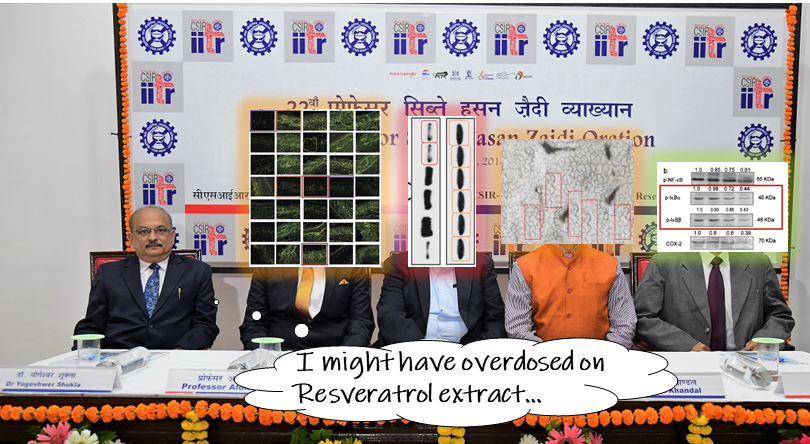

Donate!
If you are interested to support my work, you can leave here a small tip of $5. Or several of small tips, just increase the amount as you like (2x=€10; 5x=€25). Your generous patronage of my journalism will be most appreciated!
€5.00




An out-take: “Mancozeb-induced genotoxicity and apoptosis in cultured human lymphocytes”
Life Sciences (2012) doi: 10.1016/j.lfs.2011.12.013
https://pubpeer.com/publications/671AA7F0A525DA4151A909C5ED93C1
Contains lots of FACS goodness, and as noted by ‘Delphinium Cuneatum’, there’s a somersault connection to [20].
“Figure 6 (caspase 9 blot) is more similar than one would expect with figure 5 (total ERK1/2) of a previous paper from this group. The same blot with two different exposures appears to have been used after changing the orientation as illustrated below.”
LikeLike
Must credit Didymella Curtisii!
“Reversal of P-glycoprotein-mediated multidrug resistance by diallyl sulfide in K562 leukemic cells and in mouse liver”.
Carcinogenesis (2004) – doi: 10.1093/carcin/bgh060
https://pubpeer.com/publications/ECB93B72B59D541AAD2A7660F2DF7D
LikeLike
Could you put me through to Yogeshwer Shukla?
This is Chitra Mandal, CSIR – Indian Institute of Chemical biology, Kolkata, calling.
I have some important data to dicuss.
https://iicb.res.in/faculty/chitra-mandal
https://pubpeer.com/search?q=chitra+mandal
LikeLike
Dr Mamta Chawla Sarkar, ICMR-National Institute of Cholera and Enteric Diseases, Kolkota.
http://www.niced.org.in/scientists/NICEDScientists/MamtaChawlaSarkar.htm
I’ve been trying to get through to Yogeshwer Shukla for the past few days. He doesn’t answer his emails either.
Alerted by Chitra Mandal’s problems in getting through to Yogeshwer Shukla I suspect there is fault with the line.
Cholera and Enteric Diseases are of the utmost importance to India, and I was hoping that Yogeshwer Shukla’s experience of Toxicology Research could help me with some of my own toxic data.
https://pubpeer.com/search?q=chawla+sarkar
LikeLike
Three October 11th 2019 Expressions of Concern in J Biol Chem for Mamta Chawla-Sarkar.
Expression of Concern: Active participation of cellular chaperone Hsp90 in regulating the function of rotavirus nonstructural protein 3 (NSP3).
J. Biol. Chem. 2019 294: 15118. doi:10.1074/jbc.EC119.011069
Expression of Concern: Rotaviral enterotoxin nonstructural protein 4 targets mitochondria for activation of apoptosis during infection.
J. Biol. Chem. 2019 294: 15119. doi:10.1074/jbc.EC119.011070
Expression of Concern: Phosphorylation drives an apoptotic protein to activate antiapoptotic genes: Paradigm of influenza A matrix 1 prot”ein function.
J. Biol. Chem. 2019 294: 15120. doi:10.1074/jbc.EC119.011071
All three expressions of concern say the same thing:
“The publisher of the Journal of Biological Chemistry is issuing an Expression of Concern to inform readers that credible concerns have been raised regarding some of the data and conclusions in the article listed above. The Journal of Biological Chemistry will provide additional information as it becomes available.”
LikeLike
“Cholera and Enteric Diseases are of the utmost importance to India, and I was hoping that Yogeshwer Shukla’s experience of Toxicology Research could help me with some of my own toxic data.”
2019 retraction J Biol Chem. 2003 Oct 10;278(41):39461-9.
Already 3 expressions of concern J Biol Chem.
Pubpeer comments on 18 papers.
J Biol Chem. 2003 Oct 10;278(41):39461-9. Epub 2003 Jul 24.
Suppression of NF-kappa B survival signaling by nitrosylcobalamin sensitizes neoplasms to the anti-tumor effects of Apo2L/TRAIL.
Chawla-Sarkar M1, Bauer JA, Lupica JA, Morrison BH, Tang Z, Oates RK, Almasan A, DiDonato JA, Borden EC, Lindner DJ.
Author information
1
Taussig Cancer Center, Center for Cancer Drug Discovery and Development, The Cleveland Clinic Foundation, Ohio 44195, USA.
2019 retraction.
http://www.jbc.org/content/294/48/18518
This article has been withdrawn by the authors (M. Chawla Sarkar, J. A. Bauer, J. A. Lupica, A. Almasan, J. A. DiDonato, and D. J. Lindner) on request by the Journal. B. H. Morrison, Z. Tang, R. K. Oates, and E. C. Borden could not be contacted. The Journal raised questions regarding inappropriate image manipulation in Figs. 4 (A and B) and 5B. Sixteen years after the publication, the withdrawing authors were not able to locate all of the original data but were able to locate some replicates of experiments performed at the time of the original work, which the withdrawing authors state support the conclusions of the paper. The withdrawing authors’ offer to replace the images in question with alternative blots performed at the same time was declined by the Journal. The withdrawing authors state that the results of this paper are confirmed by the results of complementary experiments presented in the article and that the principal observations of this paper were further confirmed in the publications of other laboratories: 1) Huerta-Yepez, S. et al. (2004) Oncogene 23, 4993–5003; 2) Huerta-Yepez, S. et al. (2009) Nitric Oxide 20, 39–52; 3) Stupina, T. et al. (2018) Sci. Pharm. 86, E46; 4) Omar, H. A. et al. (2014) Basic Clin. Pharmacol. Toxicol. 114, 464–471. The withdrawing authors stand by the conclusions of the paper.
Pubpeer comments this paper:
https://pubpeer.com/publications/E1539115E641D7B5514F7B5F24ADBF
3 expressions of concern. Pubpeer comments on 18 papers Chawla-Sarkar:
https://pubpeer.com/search?q=Chawla-Sarkar
Report “ICMR-NICED scientist has 16 papers with duplicated, manipulated images”
https://journosdiary.com/2019/07/31/icmr-niced-mamta-chawla-sarkarduplicated-manipulated-images/
LikeLike
6th March 2020 Expression of Concern for:
J Biol Chem. 2004 Dec 10;279(50):52630-42. Epub 2004 Sep 21.
Myocardial cell death and regeneration during progression of cardiac hypertrophy to heart failure.
Sarkar S1, Chawla-Sarkar M, Young D, Nishiyama K, Rayborn ME, Hollyfield JG, Sen S.
Author information
1
Department of Molecular Cardiology, Lerner Research Institute, Taussig Cancer Center, and Cole Eye Institute, The Cleveland Clinic Foundation, Cleveland, Ohio 44195, USA.
2020 expression of concern. https://www.jbc.org/content/295/10/3386
The publisher of the Journal of Biological Chemistry is issuing an Expression of Concern to inform readers that credible concerns have been raised regarding some of the data and conclusions in the article listed above. The Journal of Biological Chemistry will provide additional information as it becomes available.
https://pubpeer.com/publications/10655807194F8BD01DB353C5BFE38C
LikeLike
2019 retraction for J Biol Chem. 2003 Oct 10;278(41):39461-9. Epub 2003 Jul 24.
2 references in retraction notice contain image duplication.
Hardly confirmation of the work in Chawla-Sarkar’s retracted paper.
J Biol Chem. 2003 Oct 10;278(41):39461-9. Epub 2003 Jul 24.
Suppression of NF-kappa B survival signaling by nitrosylcobalamin sensitizes neoplasms to the anti-tumor effects of Apo2L/TRAIL.
Chawla-Sarkar M1, Bauer JA, Lupica JA, Morrison BH, Tang Z, Oates RK, Almasan A, DiDonato JA, Borden EC, Lindner DJ.
Author information
1
Taussig Cancer Center, Center for Cancer Drug Discovery and Development, The Cleveland Clinic Foundation, Ohio 44195, USA.
Unlikely that Mamta Chawla-Sarkar reads, or looks at, Pubpeer, or Retraction Watch for that matter.
2019 retraction notice
http://www.jbc.org/content/294/48/18518
” the principal observations of this paper were further confirmed in the publications of other laboratories: 1) Huerta-Yepez, S. et al. (2004) Oncogene 23, 4993–5003; 2) Huerta-Yepez, S. et al. (2009) Nitric Oxide 20, 39–52″.
Oncogene. 2004 Jun 24;23(29):4993-5003. Nitric oxide sensitizes prostate carcinoma cell lines to TRAIL-mediated apoptosis via inactivation of NF-kappa B and inhibition of Bcl-xl expression. Huerta-Yepez S1, Vega M, Jazirehi A, Garban H, Hongo F, Cheng G, Bonavida B. Author information Department of Microbiology, Immunology, and Molecular Genetics, David Geffen School of Medicine, University of California, Los Angeles, CA 90095, USA.
Figures 3a and 3b. much more similar than you would expect. https://pubpeer.com/publications/44C0BC9605002DDBC967CEB8087476
Nitric Oxide. 2009 Feb;20(1):39-52. doi: 10.1016/j.niox.2008.08.001. Epub 2008 Aug 22. Nitric oxide sensitizes tumor cells to TRAIL-induced apoptosis via inhibition of the DR5 transcription repressor Yin Yang 1. Huerta-Yepez S1, Vega M, Escoto-Chavez SE, Murdock B, Sakai T, Baritaki S, Bonavida B. Author information Department of Microbiology, Immunology and Molecular Genetics, Jonsson Comprehensive Cancer Center, David Geffen School of Medicine, University of California, 10833 Le Conte Avenue, A2-060, Los Angeles, CA 90095-73622, USA.
Figures 2C and 5A. Much more similar than you would expect. https://pubpeer.com/publications/6D58B2B16002ED3B446E959A6C80A5
Benjamin Bonavida retractions:-
https://retractionwatch.com/2017/07/20/drip-drip-ucla-investigation-finds-image-duplications/
https://retractionwatch.com/2016/12/13/ucla-lab-pulls-two-papers-one-author-admitted-misconduct/
LikeLike
25th September retraction for:
J Biol Chem. 2011 Jun 3;286(22):20065-77. doi: 10.1074/jbc.M111.231878. Epub 2011 Apr 13.
Active participation of cellular chaperone Hsp90 in regulating the function of rotavirus nonstructural protein 3 (NSP3)
Dipanjan Dutta 1, Shiladitya Chattopadhyay, Parikshit Bagchi, Umesh Chandra Halder, Satabdi Nandi, Anupam Mukherjee, Nobumichi Kobayashi, Koki Taniguchi, Mamta Chawla-Sarkar
Affiliations collapse
Affiliation
1Division of Virology, National Institute of Cholera and Enteric Diseases, Beliaghata, Kolkata, India.
PMID: 21489987
This article has an expression of concern and there are 10 comments on PubPeer (by: Drusus Krusniki, Exochaenium Baumianum, Elisabeth M Bik, Empidonax Hammondii, Hoya Camphorifolia, Mamta Chawla-Sarkar, Dryopteris Medioxima)
PMCID: PMC3103379 DOI: 10.1074/jbc.M111.231878
2020 retraction notice.
https://www.jbc.org/content/295/39/13696
VOLUME 286 (2011) PAGES 20065–20077
This article has been withdrawn by the authors. The Journal determined that there are similar repetitive features in the background area of Figs. 4B, 5B, 6B, and 7A and Fig. S4, but the authors do not agree to the raised concerns. The authors state that they provided uncropped scans of the autoradiograms from the corresponding and/or replicate experiments done at same time of the original experiments. The authors state that due to the tropical climate, the quality of the autoradiograms may have partially deteriorated as the work was done more than 10 years ago, but still they could not visualize any repetitive elements in the background. However, the authors could not provide the original, uncropped electronic copies of the scans that were used for preparation of the published images. The authors state that all available hard copy autoradiograms present in the laboratory records were reviewed and verified favorably by the institutional review committee and a third-party forensic laboratory. The authors state that they had provided the cropped tiff files from the final assembled figures used during manuscript submission as well as figures downloaded from the JBC website to the forensic laboratory. Copies of both of the reports were shared with the Journal. The authors affirm that all the experiments were performed appropriately and the concerns raised do not affect the accuracy of the results or the conclusions of the scientific work. However, in the interest of maintaining the accuracy in the published scientific literature, the authors wish to withdraw this article but plan to publish a new version of the article corroborating the findings of this work in the future.
LikeLike
Two 2nd October 2020 J Biol Chem retractions for Mamta Chawla Sarkar:-
https://www.jbc.org/content/295/40/13956.full
Withdrawal: Rotaviral enterotoxin nonstructural protein 4 targets mitochondria for activation of apoptosis during infection.
Rahul Bhowmick, Umesh Chandra Halder, Shiladitya Chattopadhyay, Shampa Chanda, Satabdi Nandi, Parikshit Bagchi, Mukti Kant Nayak, Oishee Chakrabarti, Nobumichi Kobayashi and Mamta Chawla-Sarkar
VOLUME 287 (2012) PAGES 35004–35020
This article has been withdrawn by the authors. The Journal determined that there is an image irregularity in the background of the actin immunoblot in Fig. 3A, and there are similar repetitive features in the background area of the Cox4 immunoblot in the IP His panel from Fig. 6B, the caspase-9 immunoblot from Fig. 8D, the caspase-9 immunoblot from Fig. 8E, the caspase-9 immunoblot from Fig. 9A, and the ANT immunoblot from Fig. S1B; however, the authors do not agree to the raised concerns. The authors state that they provided uncropped scans of the autoradiograms from the corresponding and/or replicate experiments done at same time of the original experiments. The authors state that due to the tropical climate, the quality of the autoradiograms may have partially deteriorated as the work was done more than 9 years ago, but still they could not visualize any repetitive elements in the background. The authors state that all available hard copy autoradiograms present in the laboratory records were reviewed and verified favorably by the institutional review committee and a third-party forensic laboratory. The authors state that they had provided the cropped tiff files from the final assembled figures used during manuscript submission as well as figures downloaded from the JBC website to the forensic laboratory. Copies of both of the reports were shared with the Journal. However, the Journal did not agree as the authors failed to comply with the Journal’s policy of providing uncropped raw scans used to prepare the corresponding images in the manuscript. The authors affirm that all of the experiments were performed appropriately, and the concerns raised do not affect the accuracy of the results or the conclusions of the scientific work. However, to comply with Journal’s policy in maintaining the accuracy in the published scientific literature, the authors wish to withdraw this article but plan to publish a new version of the article corroborating the findings of this work in the future.
https://www.jbc.org/content/295/40/13957.full
Withdrawal: Phosphorylation drives an apoptotic protein to activate antiapoptotic genes: Paradigm of influenza A matrix 1 protein function.
Umesh Chandra Halder, Rahul Bhowmick, Tapasi Roy Mukherjee, Mukti Kant Nayak and Mamta Chawla-Sarkar
VOLUME 288 (2013) PAGES 14554–14568
This article has been withdrawn by the authors. The Journal determined that there are repetitive features present in the background area of the RelB blot in Fig. 2D and the Daxx immunoblot in Fig. 7G. There is an image irregularity in the IgG immunoblot from Fig. 4B; however the authors disagree with the Journal’s claim. The authors state that they provided uncropped scans of the autoradiograms from the corresponding and/or replicate experiments done at same time of the original experiments. The authors state that due to the tropical climate, the quality of the autoradiograms may have partially deteriorated as the work was done more than 9 years ago, but still they could not visualize any repetitive elements in the background. The authors state that all available hard copy autoradiograms present in the laboratory records were reviewed and verified favorably by the institutional review committee and a third-party forensic laboratory. The authors state that they had provided the cropped tiff files from the final assembled figures used during manuscript submission as well as figures downloaded from the JBC website to the forensic laboratory. Copies of both of the reports were shared with the Journal. However, the Journal did not agree as the authors failed to comply with the Journal’s policy of providing uncropped raw scans used to prepare the corresponding images in the manuscript. The authors affirm that all of the experiments were performed appropriately, and the concerns raised do not affect the accuracy of the results or the conclusions of the scientific work. However, in the interest of maintaining the accuracy in the published scientific literature, the authors wish to withdraw this article but plan to publish a new version of the article corroborating the findings of this work in the future.
LikeLike
Cell Death Dis. 2018 Sep 17;9(10):934. doi: 10.1038/s41419-018-0989-8.
Autophagy-independent induction of LC3B through oxidative stress reveals its non-canonical role in anoikis of ovarian cancer cells.
Satyavarapu EM1, Das R2, Mandal C3, Mukhopadhyay A3,4, Mandal C5.
Author information
1
Cancer Biology and Inflammatory Disorder Division, Council of Scientific and Industrial Research-Indian Institute of Chemical Biology, 4, Raja S.C. Mallick Road, Kolkata, 700032, India.
2
Bose Institute, P 1/12, C. I. T. Road, Scheme – VIIM, Kolkata, 700054, India.
3
Tata Medical Center, 14 MAR, Rajarhat, Kolkata, 700156, India.
4
Northern Institute for Cancer Research, Newcastle University, Newcastle, UK.
5
Cancer Biology and Inflammatory Disorder Division, Council of Scientific and Industrial Research-Indian Institute of Chemical Biology, 4, Raja S.C. Mallick Road, Kolkata, 700032, India.
Figures 1d and 4g (flipped).
LikeLike
Cell Death Dis
https://www.nature.com/cddis/editors
Editors-In Chief
Mauro Piacentini
https://pubpeer.com/publications/EC56F20BE62E55ABAD92F4EFA6A110
https://pubpeer.com/publications/5DC817BBD3617FFE9DA2FC35C806B5
https://pubpeer.com/publications/75B3F614A76B22BA95149E9509E2D6
https://pubpeer.com/publications/0F19026F0B10AB24CDB6D3061BF0AB
https://pubpeer.com/publications/CA863E20AFD3D3446376B508A4EB38
https://pubpeer.com/publications/7953571761CC4DD8AAAC8CE509DB04
https://pubpeer.com/publications/18949A468D29E2DE5A1F406D80280D
https://pubpeer.com/publications/02EE6685435E7CEC5BD6BBEBA2B7E1
https://pubpeer.com/publications/FBB3FF24161B9B876AFA49ED48EEEB
Deputy Editors
Guido Kroemer
https://forbetterscience.com/2018/10/18/lopez-otin-and-kroemer-birds-of-a-feather-flock-together/
Richard Knight
6 retractions
Enhanced IL-17 signalling following myocardial ischaemia/reperfusion injury.
Barry SP, Ounzain S, McCormick J, Scarabelli TM, Chen-Scarabelli C, Saravolatz LII, Faggian G, Mazzucco A, Suzuki H, Thiemermann C, Knight RA, Latchman DS, Stephanou A.
Int J Cardiol. 2013 Mar 10;163(3):326-334. doi: 10.1016/j.ijcard.2011.08.849. Epub 2011 Oct 24. Retraction in: Int J Cardiol. 2019 Jan 1;274:404.
PMID: 22030025
ERK and the F-box protein betaTRCP target STAT1 for degradation.
Soond SM, Townsend PA, Barry SP, Knight RA, Latchman DS, Stephanou A.
J Biol Chem. 2008 Jun 6;283(23):16077-83. doi: 10.1074/jbc.M800384200. Epub 2008 Mar 31. Retraction in: J Biol Chem. 2018 Mar 30;293(13):4954.
PMID: 18378670
Cardiac release of urocortin precedes the occurrence of irreversible myocardial damage in the rat heart exposed to ischemia/reperfusion injury.
Knight RA, Chen-Scarabelli C, Yuan Z, McCauley RB, Di Rezze J, Scarabelli GM, Townsend PA, Latchman D, Saravolatz L, Faggian G, Mazzucco A, Chowdrey HS, Stephanou A, Scarabelli TM.
FEBS Lett. 2008 Mar 19;582(6):984-90. doi: 10.1016/j.febslet.2008.02.035. Epub 2008 Feb 22. Retraction in: FEBS Lett. 2018 Feb;592(4):657.
PMID: 18295601
STAT-1 facilitates the ATM activated checkpoint pathway following DNA damage.
Townsend PA, Cragg MS, Davidson SM, McCormick J, Barry S, Lawrence KM, Knight RA, Hubank M, Chen PL, Latchman DS, Stephanou A.
J Cell Sci. 2005 Apr 15;118(Pt 8):1629-39. Epub 2005 Mar 22. Retraction in: J Cell Sci. 2015 Mar 1;128(5):1064.
PMID: 15784679
The carboxyl-terminal activation domain of the STAT-1 transcription factor enhances ischemia/reperfusion-induced apoptosis in cardiac myocytes.
Stephanou A, Scarabelli TM, Townsend PA, Bell R, Yellon D, Knight RA, Latchman DS.
FASEB J. 2002 Nov;16(13):1841-3. Epub 2002 Sep 5. Retraction in: FASEB J. 2018 Apr;32(4):2315.
PMID: 12223448
Antiapoptotic activity of the free caspase recruitment domain of procaspase-9: a novel endogenous rescue pathway in cell death.
Stephanou A, Scarabelli TM, Knight RA, Latchman DS.
J Biol Chem. 2002 Apr 19;277(16):13693-9. Epub 2002 Feb 1. Retraction in: J Biol Chem. 2015 Jan 16;290(3):1454.
PMID: 11825888
Gerry Melino
https://pubpeer.com/publications/9EAE86ADF44EEB4CACC392CD08C749#2
https://pubpeer.com/publications/547032D22F8A30801B5A6BC29D88AB
https://pubpeer.com/publications/AC122FA2B5DBCAB2184F3FB7EAB7EB
https://pubpeer.com/publications/1CDDB36421B5BE5BB4D5137C1C7CDC#2
https://pubpeer.com/publications/1CDDB36421B5BE5BB4D5137C1C7CDC#3
https://pubpeer.com/publications/31307E585573221DDB2BBEF4505F8F#2
https://pubpeer.com/publications/02EE6685435E7CEC5BD6BBEBA2B7E1#3
https://pubpeer.com/publications/CE0BE1C2DA773D503CCB068935F2CF#2
https://pubpeer.com/publications/CE0BE1C2DA773D503CCB068935F2CF#4
https://pubpeer.com/publications/3A10741901F54FD8699C1C4ACB51B8#2
https://pubpeer.com/publications/600DE5CB48FE02A8B438D6623094DB#2
https://pubpeer.com/publications/D2C2775202D75FC72F3997AAEBE538
https://pubpeer.com/publications/E987C5010AAEF8EA148A009AA3C250#2
https://pubpeer.com/publications/22923A26A375AC42875C2264AC4078
https://pubpeer.com/publications/7488A57682BDE767B66F9DF941211D#2
https://pubpeer.com/publications/7488A57682BDE767B66F9DF941211D#3
https://pubpeer.com/publications/DFAA862B8CB13672CD8B7F270DE494
https://pubpeer.com/publications/74B7CCB892732E0EFE878C3FF364EC#3
https://pubpeer.com/publications/85275786B91CF866F1D03AF399E340#2
https://pubpeer.com/publications/53EDFD34CA0B4A00CC93AA083D1E41
LikeLike
http://www.vigyanprasar.gov.in/isw/kalaazar_story.html
“A compound isolated from commonly used curry leaf, which also finds a mention in ancient Ayurvedic texts, has been found to be effective against kala azar parasite which is increasingly becoming resistant to available drugs.
The compound called mahanine isolated from leaves of Murraya koenigii, a curry plant commonly used in Indian kitchens, has been found to inhibit the growth of kala azar parasite, according to Dr Chitra Mandal, professor at Indian Institute of Chemical Biology in Kolkata, who led the study. The plant was selected for the study based on its medicinal properties described in Charaka Samhita.
“We propose the introduction of this nontoxic herbal molecule as a potential antileishmanial agent. There is also the opportunity to use this herbal remedy as a combinational chemotherapeutic agent along with traditional antileishmanial drugs”
Kala azar is caused by a protozoan parasite Leishmania donovani. Nearly 40,000 cases of kala azar are registered annually in the Indian subcontinent. An oral drug, miltefosine, is available to cure this disease but the parasite is becoming resistant to it.
A low dose of 11 micromolar of mahanine killed more than 90% of the parasites in culture at 48 hours. The compound increases death-inducing reactive oxygen species in parasite as well as cells that harbor the parasite. As a result, parasite’s DNA gets degraded. It has also been used in laboratory mouse who were fed with it for five consecutive days. The results were comparable to a dose of miltefosine, according to results of the study published in journal Scientific Reports.”
Mahanine data here:-
https://pubpeer.com/publications/B399F57078291DDB0DEE58E9A29598
https://pubpeer.com/publications/03B5B6CF0B1BBEEFE878AEFB6788F1#2
https://pubpeer.com/publications/03B5B6CF0B1BBEEFE878AEFB6788F1#3
https://pubpeer.com/publications/03B5B6CF0B1BBEEFE878AEFB6788F1#4
LikeLike
Cell Death Dis. 2018 Feb 12;9(2):210. doi: 10.1038/s41419-017-0191-4.
Association of cytosolic sialidase Neu2 with plasma membrane enhances Fas-mediated apoptosis by impairing PI3K-Akt/mTOR-mediated pathway in pancreatic cancer cells.
Nath S1, Mandal C2, Chatterjee U3, Mandal C4.
Author information
1
Cancer Biology and Inflammatory Disorder Division, Council of Scientific and Industrial Research (CSIR), Indian Institute of Chemical Biology (IICB), 4, Raja S.C. Mullick Road, Jadavpur, Kolkata, 700032, West Bengal, India.
2
National Institute of Pharmaceutical Education and Research, IICB, CSIR, Kolkata, 700032, West Bengal, India.
3
Department of Pathology, Institute of Postgraduate Medical Education and Research, Institute of Post-Graduate Medical Education and Research Hospital, Kolkata, 700020, West Bengal, India.
4
Cancer Biology and Inflammatory Disorder Division, Council of Scientific and Industrial Research (CSIR), Indian Institute of Chemical Biology (IICB), 4, Raja S.C. Mullick Road, Jadavpur, Kolkata, 700032, West Bengal, India.
Figure 6a.
Even though they are zero time points you need a field of cells which will be mock treated and a field of cells whcih will have neu2 overexpresseion. The same field of cells cannot have both fates.
LikeLike
https://pubpeer.com/publications/80B98F8CB2C19F51831AB21A21BDAF#12
commented September 19th, 2015 1:30 PM and accepted September 19th, 2015 1:30 PM
There is one other similar to Dr. Chitra Mandal
Dr. S Sandhya Swaminathan
http://www.neeri.res.in/divisonal_details.php?DIV=30
https://www.researchgate.net/profile/Sandhya_Swaminathan
Chief Scientist, Head of Institute, CSIR-NEERI, Nagpur, India
has extensive plagiarism in many of her publications
Promoted as Chief Scientist last month
https://pubpeer.com/publications/C4CB2C560847959110C9E770AC10B4
https://pubpeer.com/publications/711A8A3259B4F30710FCFA4EEF954A
https://pubpeer.com/publications/CE152BDC43B721D5C1A2892585FB6A
https://pubpeer.com/publications/4B7FF84B89CE2A9A3EEE2707975124
https://pubpeer.com/publications/BC8D1CAC29C3BECFFC6E76B288A4FC
https://pubpeer.com/publications/68A48726F1A5783261C598A94A18AB
LikeLike
https://www.biospectrumindia.com/news/58/12739/ministry-of-st-csir-iicb-release-first-ayurvedic-cancer-drug.html
“Ministry of S&T, CSIR-IICB release first ayurvedic cancer drug
06 February 2019 | News
“Kudos CM 9” the first ever ayurvedic invention in the World for Cancer treatment researched & developed by Ministry of Science & Technology, CSIR-IICB (Council of Scientific & Industrial Research-Indian Institute of Chemical Biology) was recently launched. This is the world’s first non-chemical, non-synthetic Ayurvedic Drug to combat the deadly menace of cancer.
Prof. Chitra Mandal, Senior Scientist, Cancer Biology & Inflammatory Disorder Division, CSIR- IICB said, “Kudos CM9 is the result of 30 years of extensive research by Ministry of Science & Technology, CSIR-IICB to find the first ever ayurvedic cancer cure drug which has no side effects and has been proven to be the most effective and the safest medicine for the dreadful disease Cancer.”
References: https://pubpeer.com/search?q=chitra+mandal
LikeLike
2009 retraction for Chitra Mandal.
Infect Immun. 2009 Jan 29. [Epub ahead of print]
RETRACTED: Sialic acids, important constituents and selective recognition factors of Pseudomonas aeruginosa, an opportunistic pathogen.
Khatua B1, Ghoshal A, Bhattacharya K, Mandal C, Crocker PR, Mandal C.
Author information
1
Infectious diseases and Immunology Division, Indian Institute of Chemical Biology, 4, Raja S.C. Mullick Road, Kolkata-700 032; College of Life Sciences, University of Dundee, Dundee, DD1 5EH, UK.
PMID: 19103775
DOI: 10.1128/IAI.01083-08
Pubpeer: https://pubpeer.com/publications/D1911F60712E456C371E4409775E1C#2
Reasons not given, but looks like image duplication.
LikeLike
2019 retraction for Chitra Mandal.
1, PLoS One. 2012;7(7):e42361. doi: 10.1371/journal.pone.0042361. Epub 2012 Jul 31.
8 comments on PubPeer (by: Peer 1, Unregistered Submission, Acanthometra Fusca, Pluchea Kelleri, Elisabeth M Bik, Hoya Camphorifolia)
Sialoglycosylation of RBC in visceral leishmaniasis leads to enhanced oxidative stress, calpain-induced fragmentation of spectrin and hemolysis.
Samanta S1, Ghoshal A, Bhattacharya K, Saha B, Walden P, Mandal C.
Author information
1
Cancer Biology and Inflammatory Disorder Division, CSIR-Indian Institute of Chemical Biology, Kolkata, India.
Pubpeer: https://pubpeer.com/publications/BBA1570F0E0528B668FB27F7195044
2019 retraction.
https://journals.plos.org/plosone/article?id=10.1371/journal.pone.0224539
Concerns have been raised about results reported in Figs 1F and 4C of this article [1]:
In Fig 1F, a cell with aberrant morphology appears to be duplicated within the RBCVL (sensitized) panel, and a cell cluster in this panel appears similar to a cluster in the RBCVL (unsensitized) panel. The RBCVL (sensitized) and RBCVL (unsensitized) panels appear to include several cells and cell clusters that overlap with Fig 3B of [2]. Also, the RBCN (sensitized) panel appears to overlap with data reported in Fig 3A in [2]. The images including similar elements represent different experiments in [1] and [2].
When levels are adjusted to visualize background details, background areas within lanes 1 and 11 of Fig 4C appear more similar than would be expected for independent results, although the bands are different in the two lanes.
The authors commented that an error was made in preparing Fig 1F and they provided alternate data for the RBCN (sensitized) and RBCVL (both) panels. The image offered as a replacement for the RBCVL-sensitized panel included cells with aberrant morphologies that appear similar to cell images in the original figure and in Fig 3B of [2].
The original images supporting results in Fig 4 are no longer available.
The PLOS ONE Editors retract this article due to these unresolved concerns, which call into question the reliability of the results reported in Figs 1F and 4C.
CM did not agree with the retraction. The other authors did not respond or could not be reached.
Additionally, Fig 1F is excluded from this article’s [1] license because it reports material from [2], published 2007 [Elsevier Inc.], which is not offered under a CC-BY license. At the time of retraction, the article [1] was republished to note this exclusion in the Fig 1 legend and the article’s copyright statement.
Reference
1.Samanta S, Ghoshal A, Bhattacharya K, Saha B, Walden P, Mandal C (2012) Sialoglycosylation of RBC in Visceral Leishmaniasis Leads to Enhanced Oxidative Stress, Calpain-Induced Fragmentation of Spectrin and Hemolysis. PLoS ONE 7(7): e42361. https://doi.org/10.1371/journal.pone.0042361 pmid:22860118
2.Mukherjee K, Chowdhury S, Mondal S, Mandal C, Chandra S, Bhadra RK, et al. (2007) 9-O-acetylated GD3 triggers programmed cell death in mature erythrocytes. Biochem Biophys Res Commun 362(3):651–7. https://doi.org/10.1016/j.bbrc.2007.08.048 pmid:17761143
LikeLike
3 retractions Chitra Mandal.
Sialoglycosylation of RBC in visceral leishmaniasis leads to enhanced oxidative stress, calpain-induced fragmentation of spectrin and hemolysis. Samanta S, Ghoshal A, Bhattacharya K, Saha B, Walden P, Mandal C.
PLoS One. 2012;7(7):e42361. doi: 10.1371/journal.pone.0042361. Epub 2012 Jul 31.
Retraction in: PLoS One. 2019 Oct 24;14(10):e0224539. PMID: 22860118
.
Bak compensated for Bax in p53-null cells to release cytochrome c for the initiation of mitochondrial signaling during Withanolide D-induced apoptosis. Mondal S, Bhattacharya K, Mallick A, Sangwan R, Mandal C.
PLoS One. 2012;7(3):e34277. doi: 10.1371/journal.pone.0034277. Epub 2012 Mar 29.
Retraction in: PLoS One. 2020 Feb 3;15(2):e0228839. PMID: 22479585
RETRACTED: Sialic acids, important constituents and selective recognition factors of Pseudomonas aeruginosa, an opportunistic pathogen. Khatua B, Ghoshal A, Bhattacharya K, Mandal C, Crocker PR, Mandal C.
Infect Immun. 2009 Jan 29. [Epub ahead of print]
PMID: 19103775
LikeLike
The ‘bubble and hairline’ control, for instance, first spotted in 2004 with five lanes for five experimental levels of garlic [21]
Whoops, up to 11 sightings already!

Kalra et al (2006) – more garlic: https://pubpeer.com/publications/8123113071476EBDEF55EDEE231182
Madan et al (2008) – grapeskins again. https://pubpeer.com/publications/15094E64ADDFEDF790E810B4E056EA
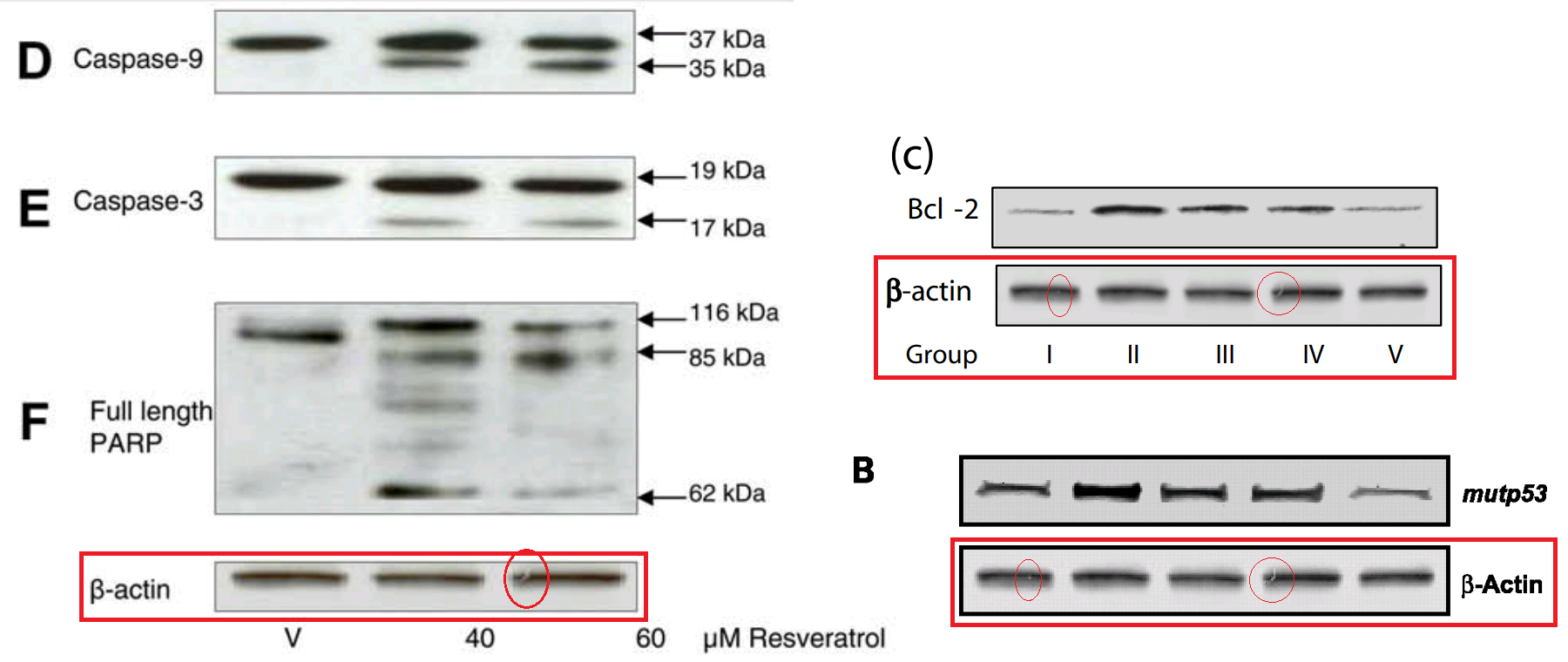
LikeLike
Pingback: With 73 problematic papers listed on Pubpeer, Indian Institute of Toxicology Research has a serious problem – Science Chronicle
SEE ALSO
PRASAD COLUMN IN THE HINDU———-INDIA TOP NEWS PAPER
https://www.thehindu.com/sci-tech/science/with-73-problematic-papers-listed-on-pubpeer-indian-institute-of-toxicology-research-has-a-serious-problem/article27378819.ece
LikeLike
https://www.thehindu.com/sci-tech/science/with-73-problematic-papers-listed-on-pubpeer-indian-institute-of-toxicology-research-has-a-serious-problem/article27378819.ece
LikeLike
Pingback: Topi con il mal di pancia - Ocasapiens - Blog - Repubblica.it
A few more hand-crafted FACS histograms that were left out in the sun and started to melt:

Figures 2(B, C) from [22].
LikeLike
Pingback: Weekly Digest, June 1, 2019 – Science Integrity Digest
MORE FROM THE HINDU
NAME AND SHAME
https://www.thehindu.com/sci-tech/science/additional-33-problematic-papers-from-csir-indian-institute-of-toxicology-research-listed-on-pubpeer/article27399845.ece
LikeLike
“After that he ascended to the MD Anderson Cancer Center (University of Texas) to work with Bharat Aggarwal and co-author a string of papers, later retracted because the amount of fabrication in them exceeded editorial tolerance.”
Slightly worrying.
https://nccih.nih.gov/health/ayurveda/introduction.htm#hed4
“Is Ayurvedic Medicine Safe?
Some Ayurvedic preparations may contain lead, mercury, or arsenic in amounts that can be toxic.
Is Ayurvedic Medicine Effective?
A few studies suggest that Ayurvedic preparations may reduce pain and increase function in people with osteoarthritis and help manage symptoms in people with type 2 diabetes, but most of these trials are small or not well-designed. There is little scientific evidence on Ayurveda’s value for other health issues.
Yet,
NCCIH-Funded Research
NCCIH is funding research that:
Builds on earlier investigations in breast cancer survivors that found a positive effect of integrated Ayurvedic medicine on improved quality of life; new research will evaluate ways to make this intervention easier to incorporate into peoples’ lives. The proposed Ayurvedic intervention includes diet, lifestyle, yoga, and pressure point treatment.
Studies the mechanism by which an extract from Butea monosperma (BME) flowers may protect against joint destruction from osteoarthritis (BME is widely used in Ayurveda for arthritis and other inflammatory diseases in India).
There is no significant regulation of Ayurvedic practice or education in the United States, and no state requires a practitioner to have a license. For more information on credentialing complementary health practitioners, see the NCCIH fact sheet Credentialing, Licensing, and Education.
Other References
Darvesh AS, Aggarwal BB, Bishayee A. Curcumin and liver cancer: a review. Current Pharmaceutical Biotechnology. 2012;13(1):218-228.
This page last modified January 14, 2019”
Is the NIH gormless, or just behind the times?Ofentimes several blocks behind the perps.
http://retractiondatabase.org/RetractionSearch.aspx?AspxAutoDetectCookieSupport=1#?AspxAutoDetectCookieSupport%3d1%26auth%3dAggarwal%252c%2bBharat%2bB
LikeLike
Is the NIH gormless, or just behind the times?
You have to remember that the NCCIH was established specifically to serve the needs of supplement peddlers and Alt-Med scammers, and tasked with finding evidence to support Alt-Med claims, whatever level of mendacity that might require.
“Ayurvedic treatment combines products (mainly derived from plants, but may also include animal, metal, and mineral), diet, exercise, and lifestyle.”
It would be more accurate and perhaps less tendentious if they wrote “Ayurvedic treatment combines whatever crap a given ayurvedic scammer happens to be selling”. There is no single coherent scholium of thought… just a loose bundle of different traditions of medieval superstition. The toxic-metal alchemy aspect is pretty pervasive, though (not just “may include”).
This compels the ideologues, apologists and more dedicated fraudsters to explain that the Ayurvedic processing of arsenic (and lead, mercury, cadmium, whatever) performs an Alchemical transformation so that they are no longer toxic: https://www.npr.org/sections/health-shots/2015/07/31/428016419/toxic-lead-contaminates-some-traditional-ayurvedic-medicines
These bhasmas are put through a complicated process sometimes involving goat’s urine or other acidic liquids that are said to detoxify heavy metals. In an email, Ayurveda scientist Kalpana Joshi at the University of Pune in India says Western scientists might have a lack of understanding about this process. “I do understand the skepticism of Western doctors. I believe adverse effects [experienced by patients] are due to not following right Ayurvedic methods and faulty shortcuts for large scale productions,” she writes.
In recent years, scientists like Joshi have been trying to use Western scientific method approaches to validate Ayurvedic claims. “Rasa sindur is a mercury preparation, and papers have proved it to be safe, nontoxic and improving life-span in fly models,” Joshi writes.
There are no adverse effects, and when there are, it wasn’t really Ayurveda.
LikeLike
Pingback: CSIR-IITR case is being investigated speedily: CSIR Director-General Shekhar Mande – Science Chronicle
THE WIRE COVERAGE ON THE BLOG
https://thewire.in/the-sciences/indian-institute-of-toxicology-research-plagiarism-journals
LikeLike
Reblogged this on Doctordoalittle.
LikeLike
“Shukla, who probably will proclaim resveratrol’s antioxidative powers even after his 5th bottle of red wine, also used to be the General Secretary of Environmental Mutagen Society of India and the Indian Society of Toxicology.”
Shukla is only following tradition. Not such an old one, but a tradition nevertheless.
http://retractionwatch.com/2012/01/11/uconn-resveratrol-researcher-dipak-das-fingered-in-sweeping-misconduct-case/
“One area of interest for Das, a government-funded professor of surgery and director of the Cardiovascular Research Center, has been resveratrol, a substance in red wine that has allegedly been linked to improved cardiac health.”
https://retractionwatch.com/2014/03/27/late-resveratrol-researcher-dipak-das-up-to-20-retractions/
http://retractiondatabase.org/RetractionSearch.aspx#?auth%3dDas%252c%2bDipak%2bK
.
LikeLike
Leuk Res. 2010 Apr;34(4):463-70. doi: 10.1016/j.leukres.2009.07.042. Epub 2009 Aug 25.
4 comments on PubPeer (by: Unregistered Submission, Peer 1, Peer 3)
Elevated mRNA level of hST6Gal I and hST3Gal V positively correlates with the high risk of pediatric acute leukemia.
Mondal S1, Chandra S, Mandal C.
Author information
1
Infectious Diseases and Immunology Division, Indian Institute of Chemical Biology, An Unit of Council of Scientific and Industrial Research, Govt of India, 4 Raja SC Mullick Road, Kolkata 700032, India.
Already has this at Pubpeer: https://pubpeer.com/publications/46E0DEB435501F731F2DCA48A462C9#2
Figure 4(A) is also problematic.
LikeLike
Problematic? You think so?
LikeLike
Yeah! Problematic.
Rightmost two lanes are from different leukemias (B-ALL and T-ALL) so should be different samples.
Odd that many features in those lanes are very similar.
I did notice the rectangular defect and the vertical defect in the lanes to the left of those, but image duplication is the most difficult to explain away.
LikeLike
The Scientist reporting.
https://www.the-scientist.com/news-opinion/research-institute-investigates-possible-image-manipulation-in-papers-65998
LikeLike
Pingback: De coccio - Ocasapiens - Blog - Repubblica.it
5 retractions: https://www.ncbi.nlm.nih.gov/pubmed/?term=shukla%20y%20retracted
RETRACTED: Tea polyphenols enhance cisplatin chemosensitivity in cervical cancer cells via induction of apoptosis.
Singh M, Bhui K, Singh R, Shukla Y.
Life Sci. 2013 Jul 19;93(1):7-16. doi: 10.1016/j.lfs.2013.02.001. Epub 2013 Feb 9. Erratum in: Life Sci. 2019 Aug 19;:116690.
PMID: 23399702
Resveratrol and black tea polyphenol combination synergistically suppress mouse skin tumors growth by inhibition of activated MAPKs and p53.
George J, Singh M, Srivastava AK, Bhui K, Roy P, Chaturvedi PK, Shukla Y.
PLoS One. 2011;6(8):e23395. doi: 10.1371/journal.pone.0023395. Epub 2011 Aug 26. Retraction in: PLoS One. 2019 Apr 19;14(4):e0215980.
PMID: 21887248
Role of senescence and mitotic catastrophe in cancer therapy.
Singh R, George J, Shukla Y.
Cell Div. 2010 Jan 21;5:4. doi: 10.1186/1747-1028-5-4. Retraction in: Cell Div. 2012;7:15.
PMID: 20205872
RETRACTED: Resveratrol induces apoptosis involving mitochondrial pathways in mouse skin tumorigenesis.
Kalra N, Roy P, Prasad S, Shukla Y.
Life Sci. 2008 Feb 13;82(7-8):348-58. doi: 10.1016/j.lfs.2007.11.006. Epub 2007 Nov 28. Erratum in: Life Sci. 2019 Aug 19;:116691. Retraction in: Life Sci. 2016 Jul 15;157:107.
PMID: 18201729
Theaflavins induced apoptosis of LNCaP cells is mediated through induction of p53, down-regulation of NF-kappa B and mitogen-activated protein kinases pathways.
Kalra N, Seth K, Prasad S, Singh M, Pant AB, Shukla Y.
Life Sci. 2007 May 16;80(23):2137-2146. doi: 10.1016/j.lfs.2007.04.009. Epub 2007 Apr 21. Retraction in: Life Sci. 2019 Feb 15;219:364.
PMID: 17499812
LikeLike
Retraction Watch makes it 5 retractions too.
https://retractionwatch.com/2019/08/27/cancer-researcher-up-to-five-retractions/
LikeLike